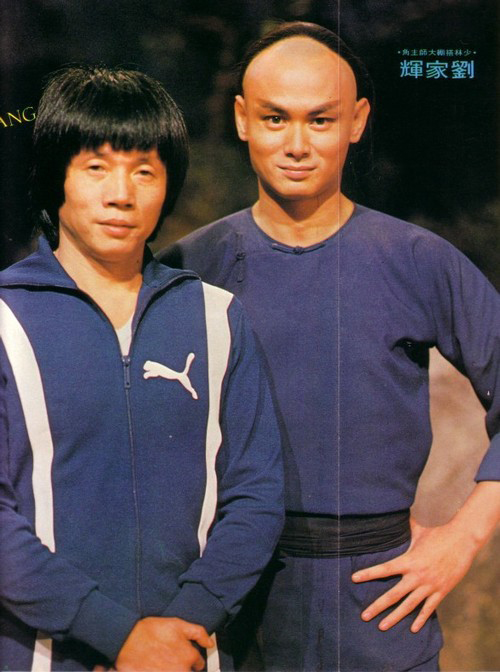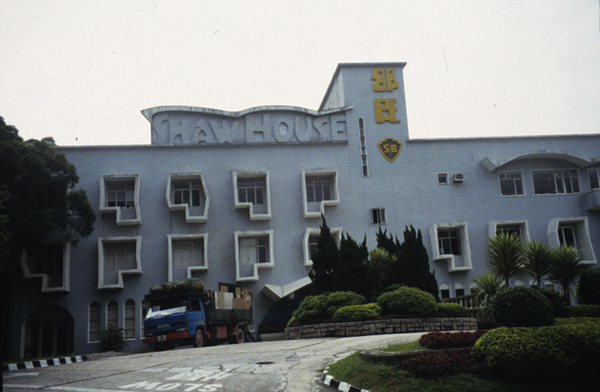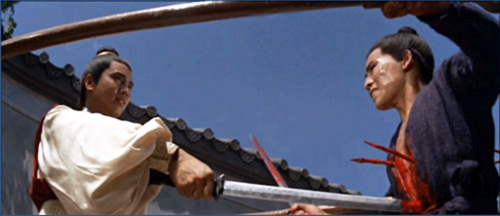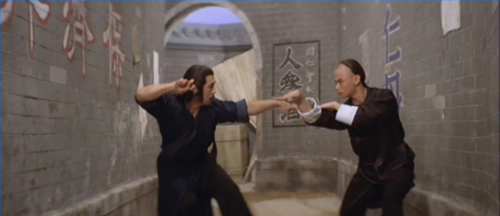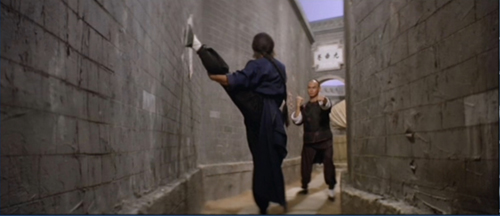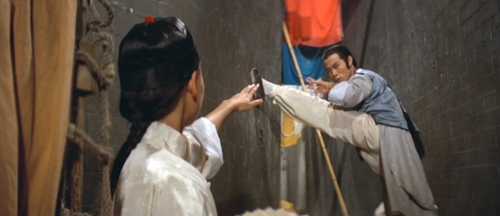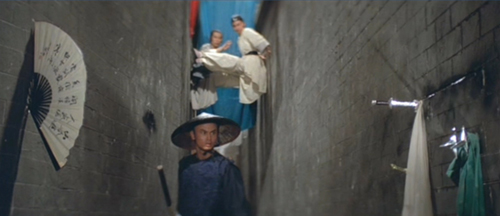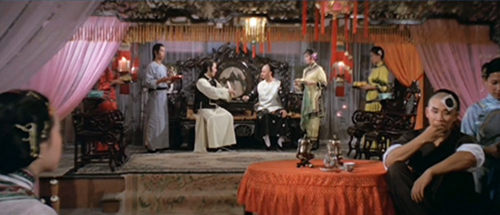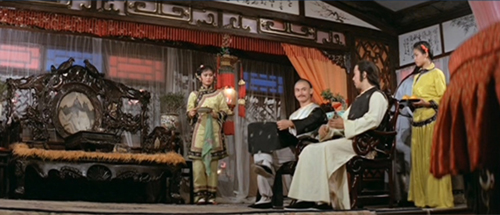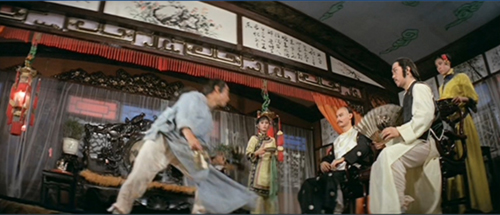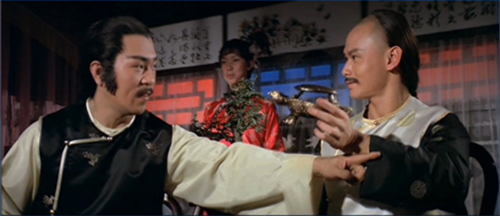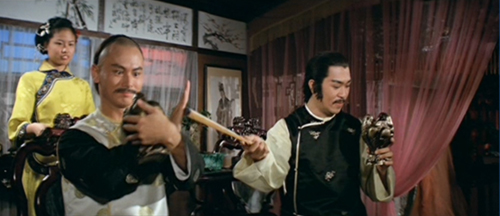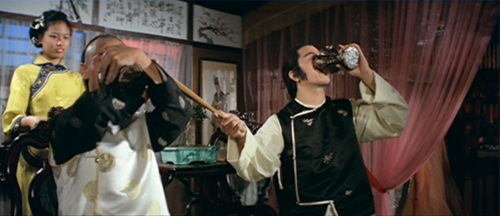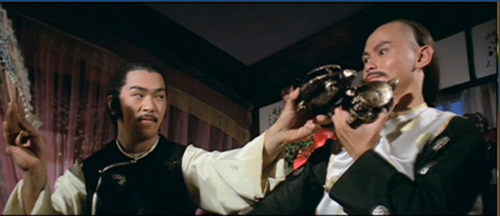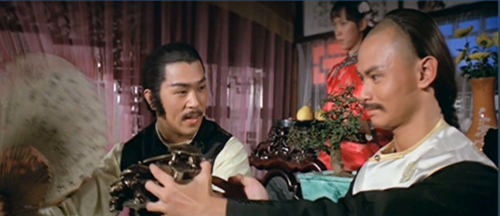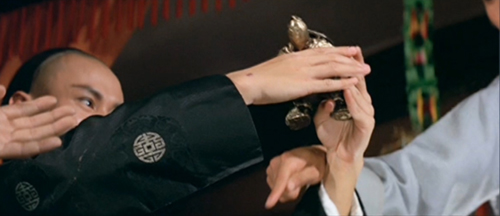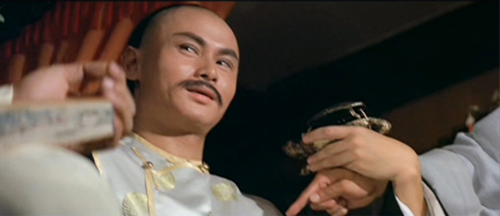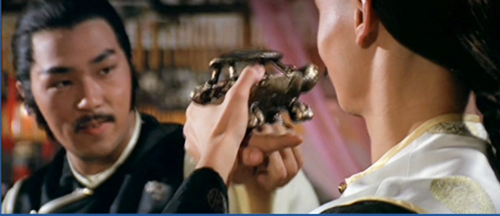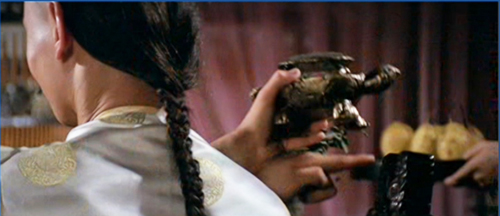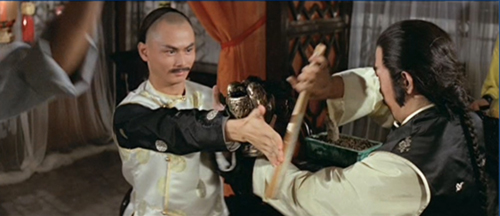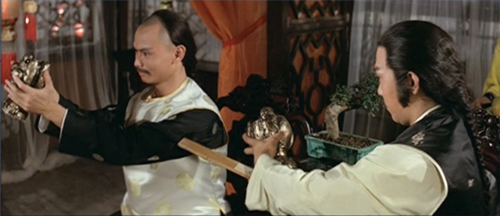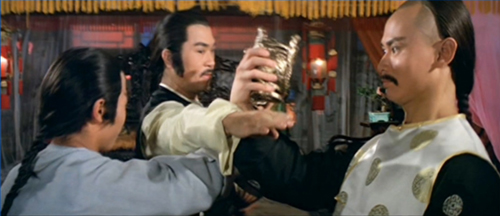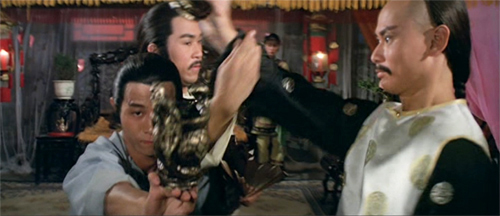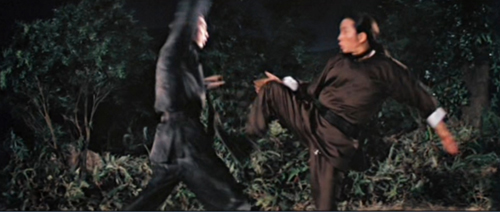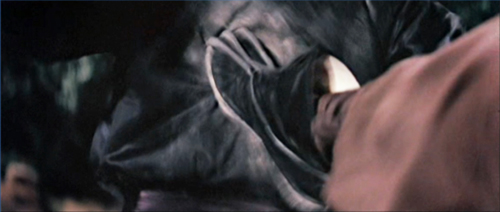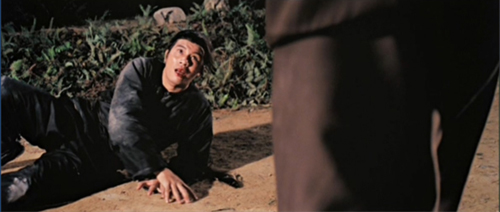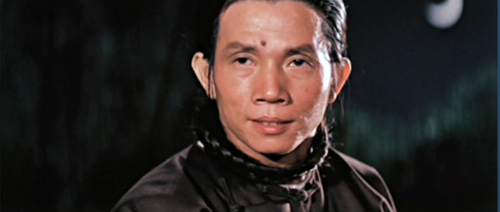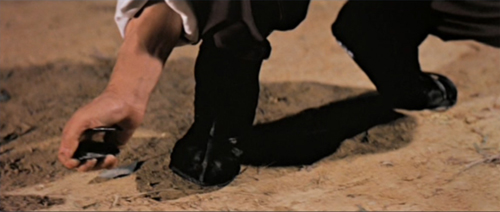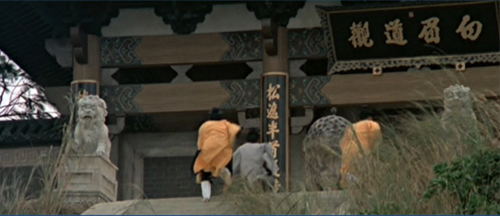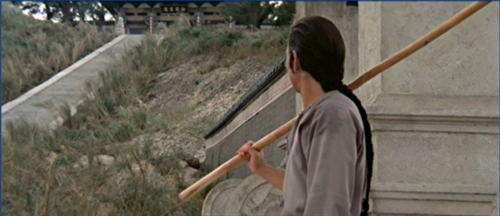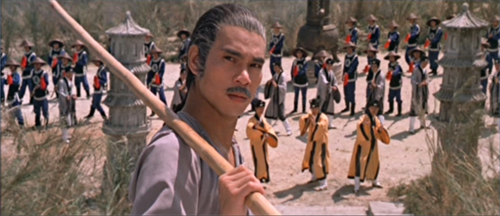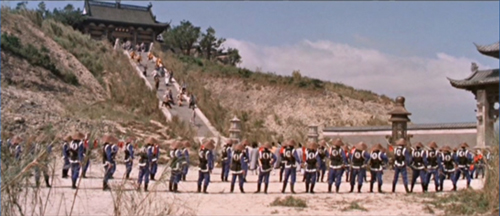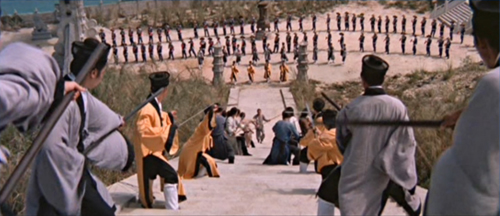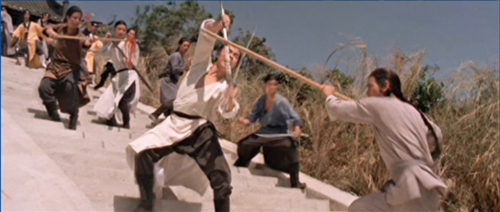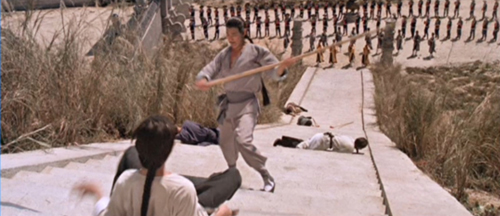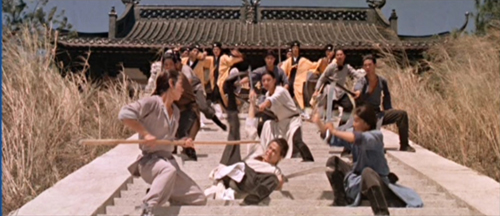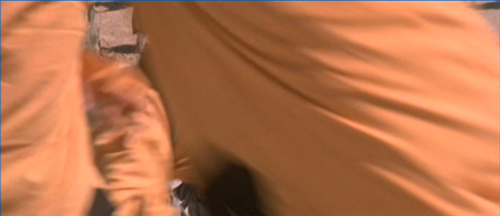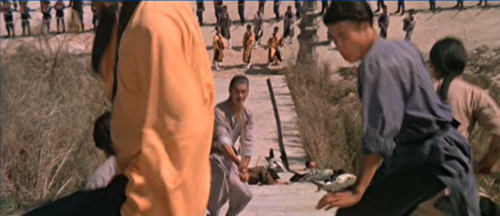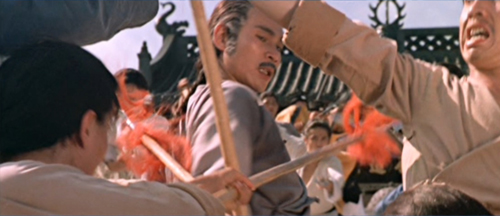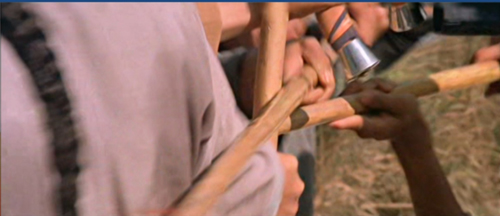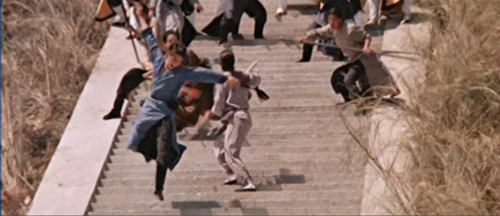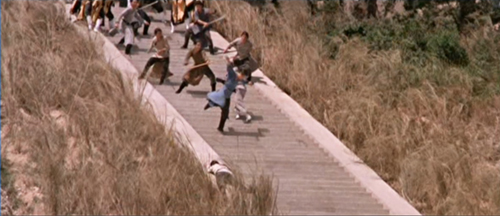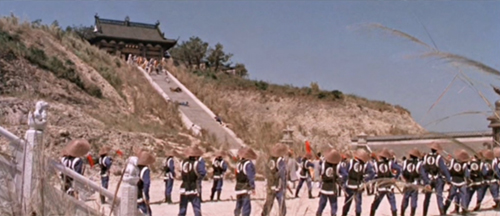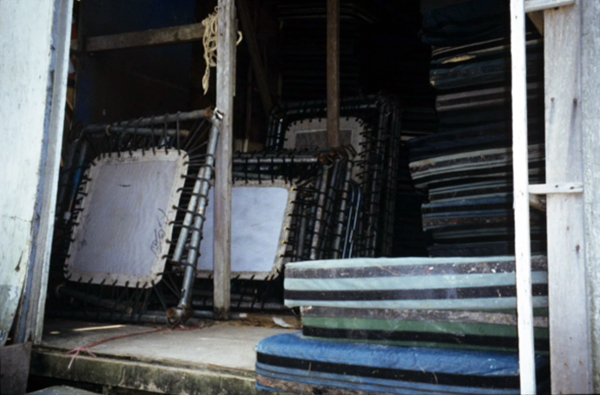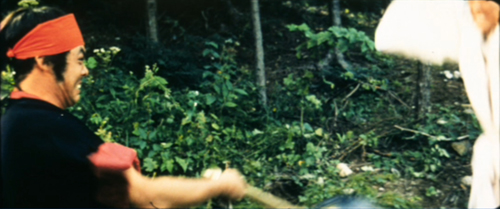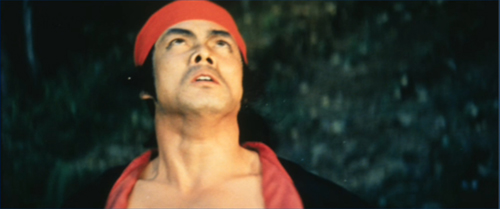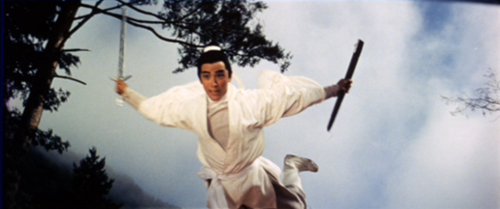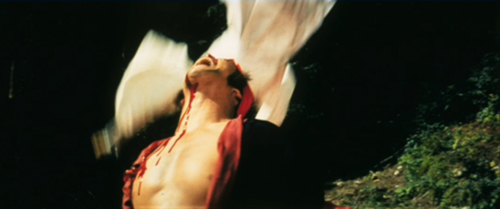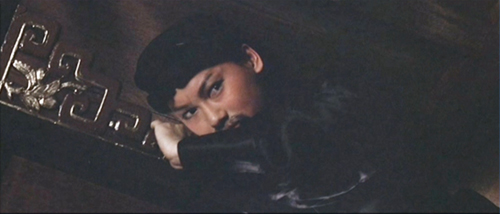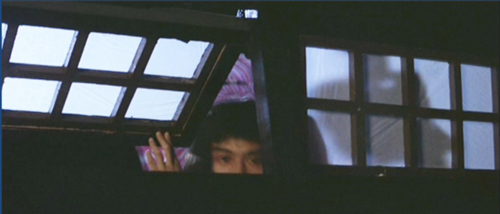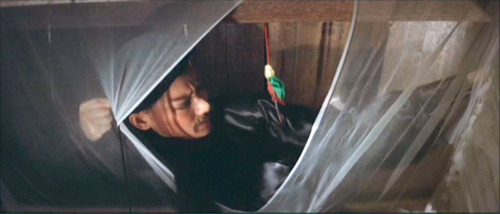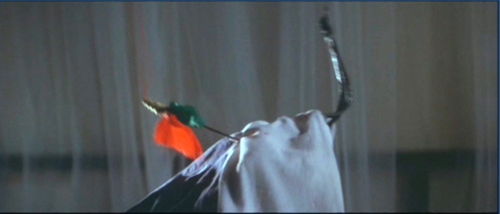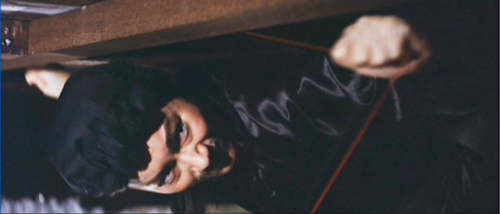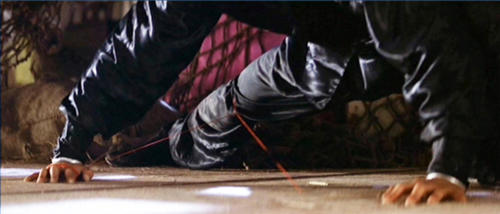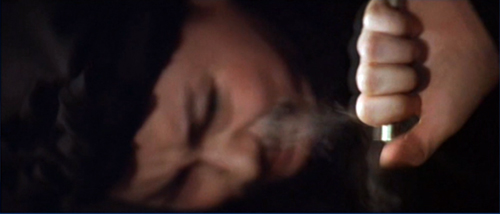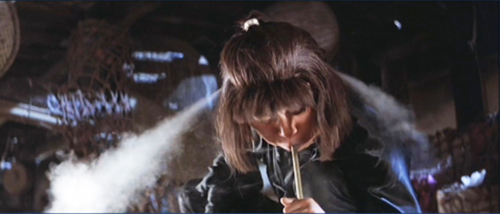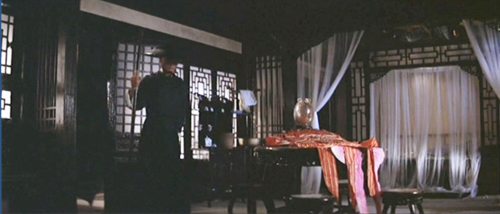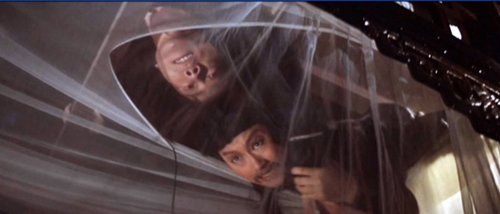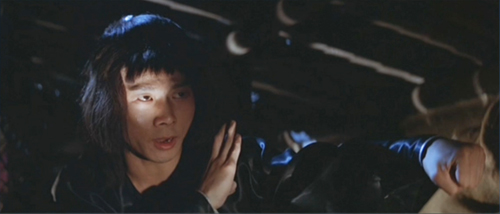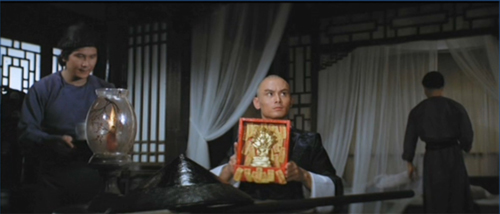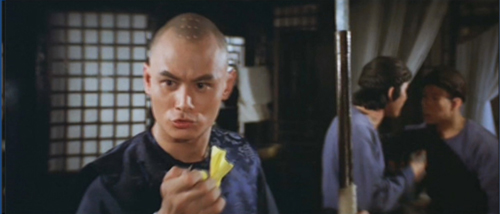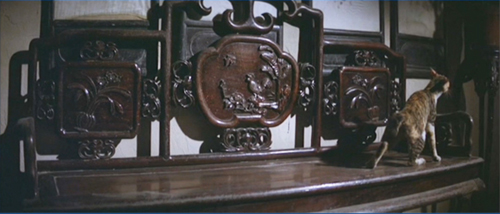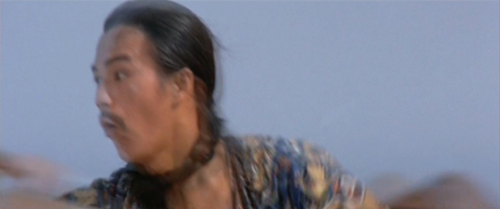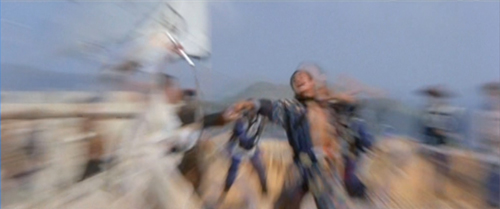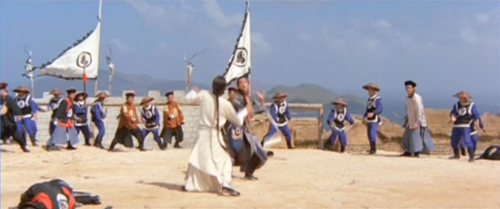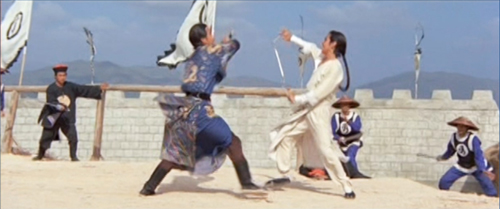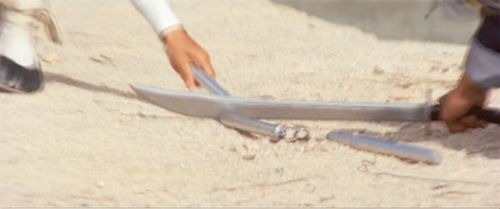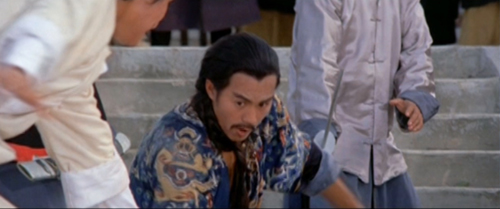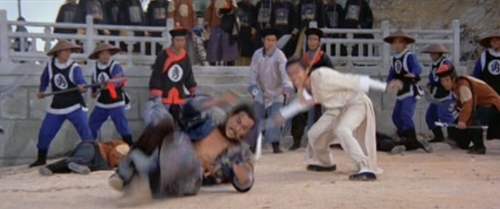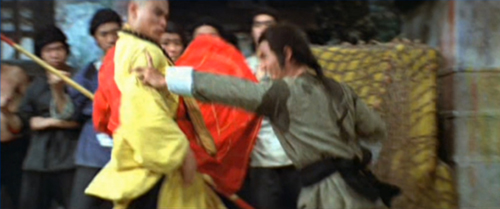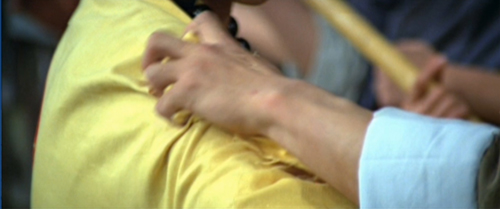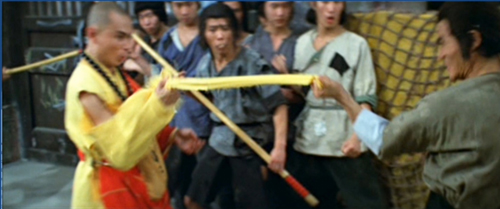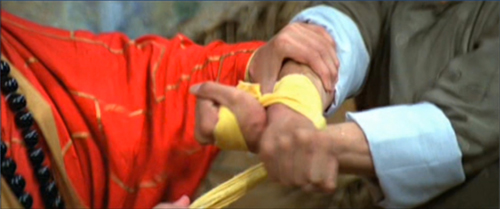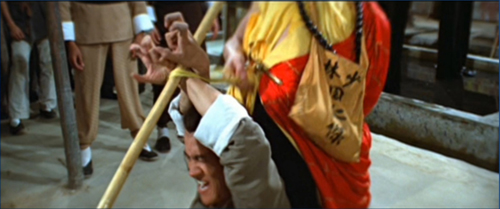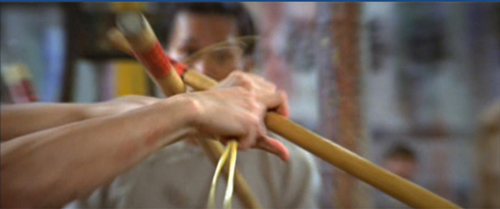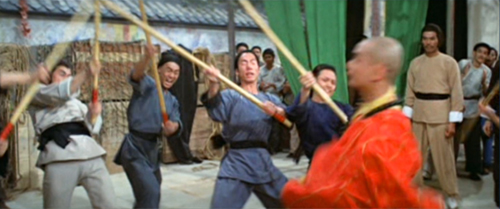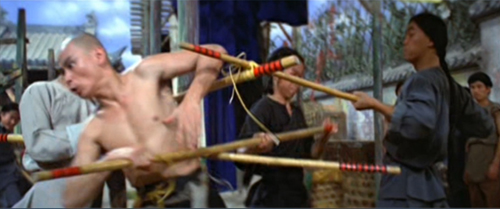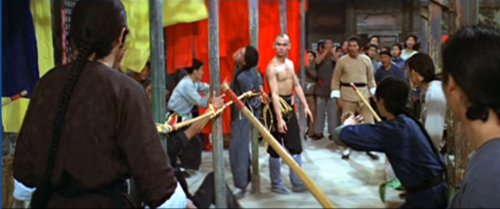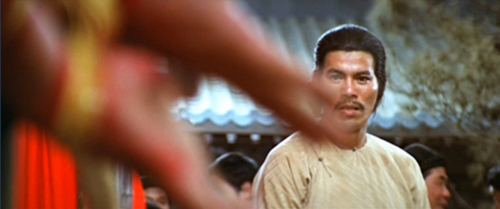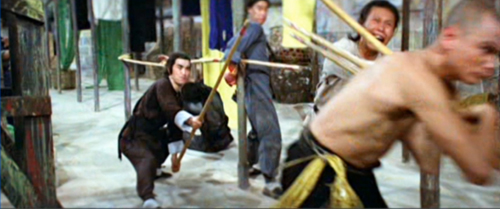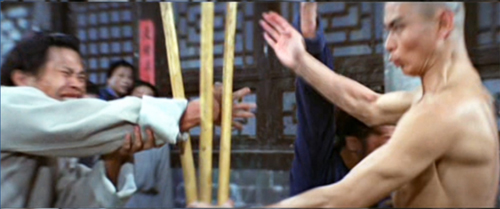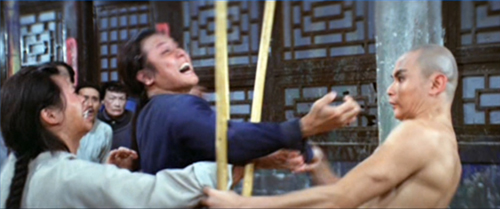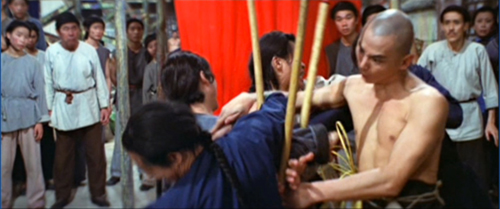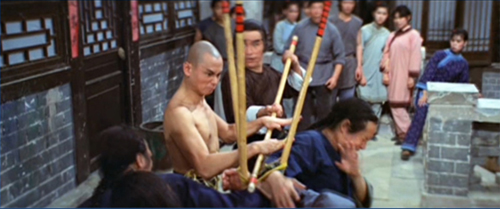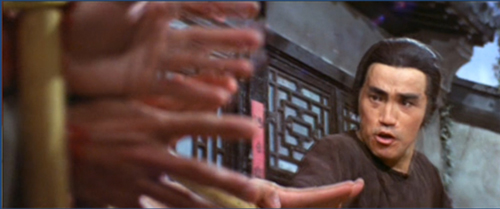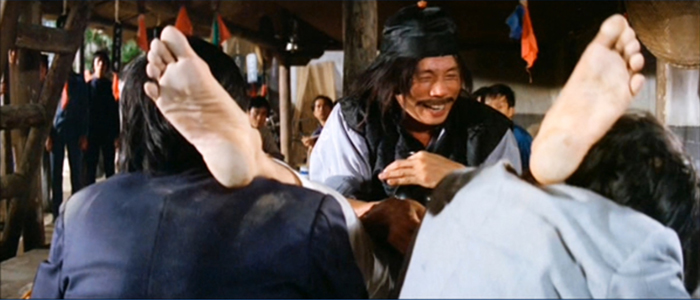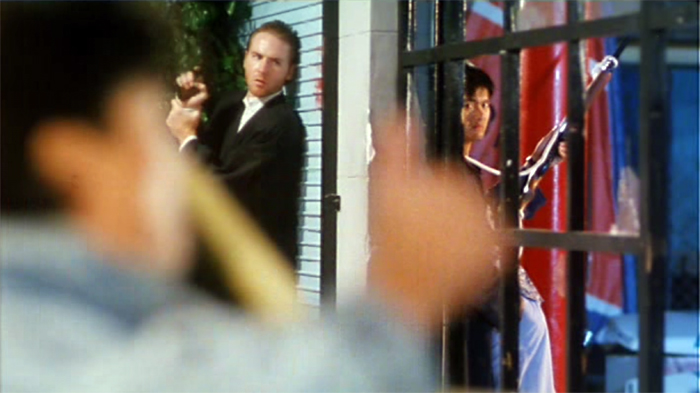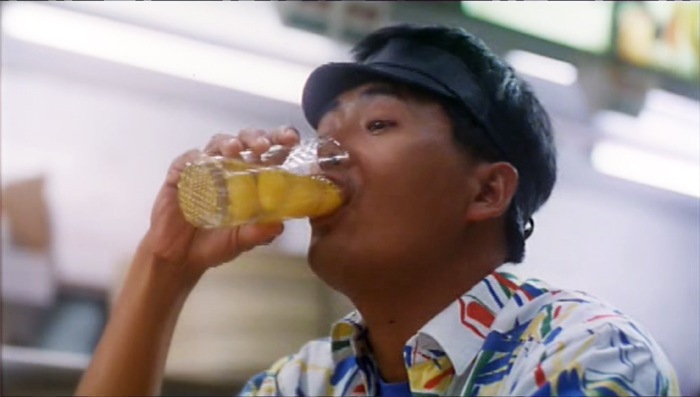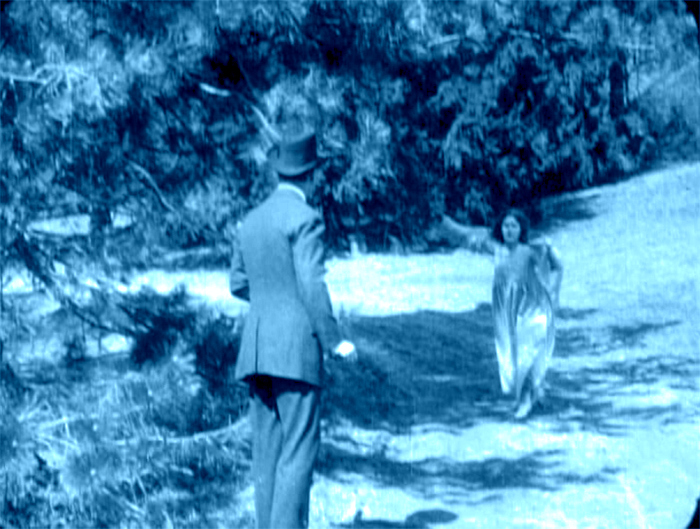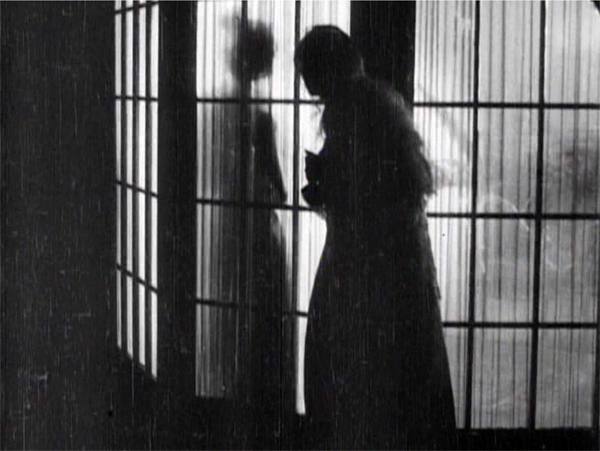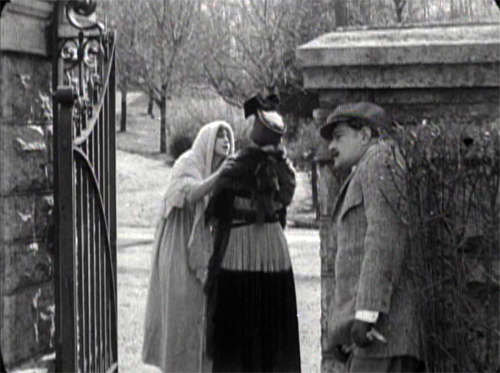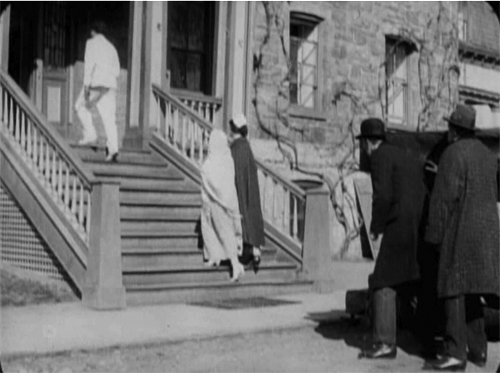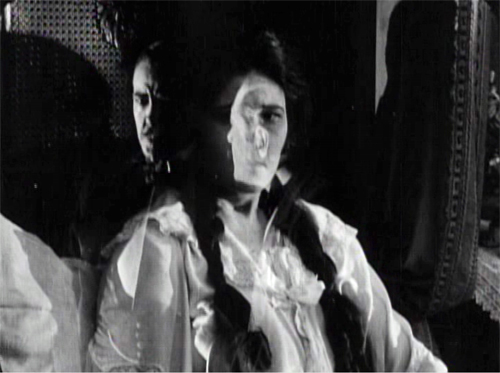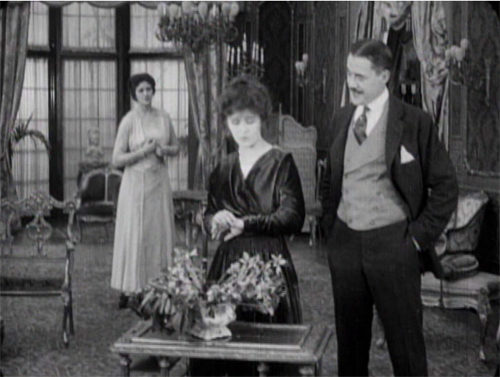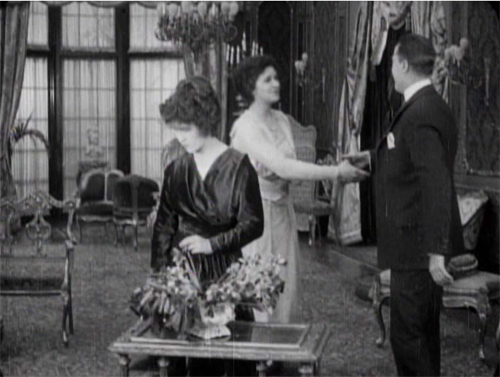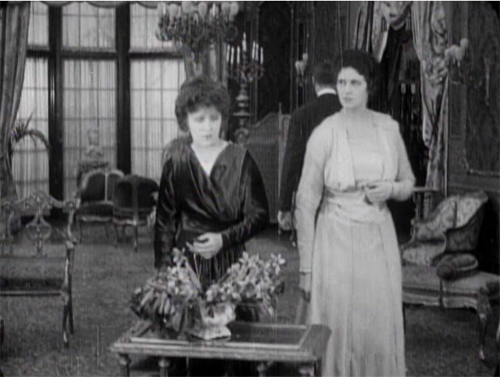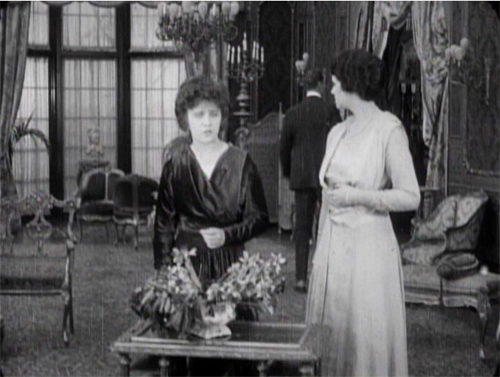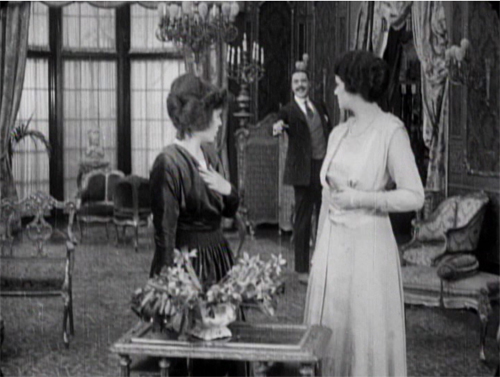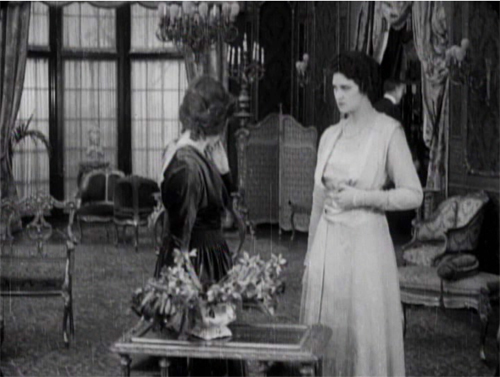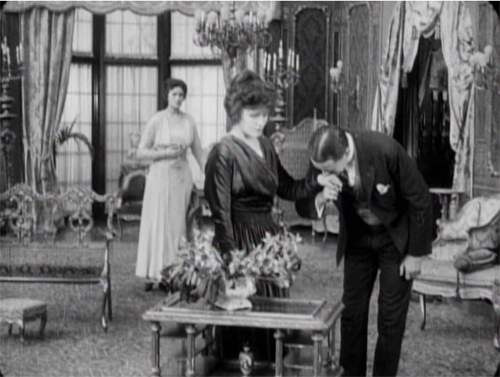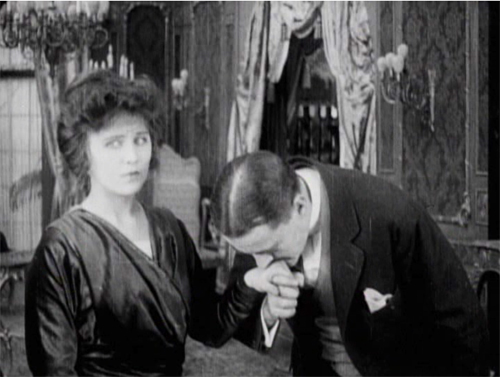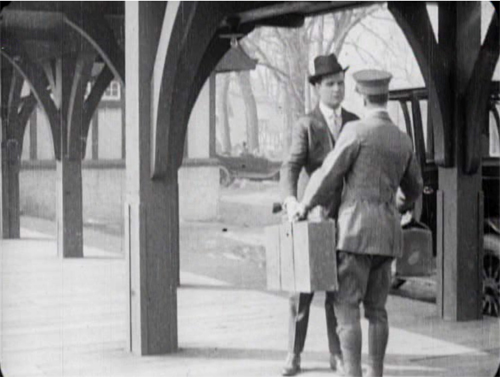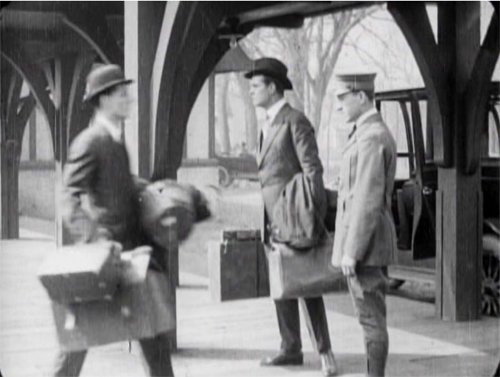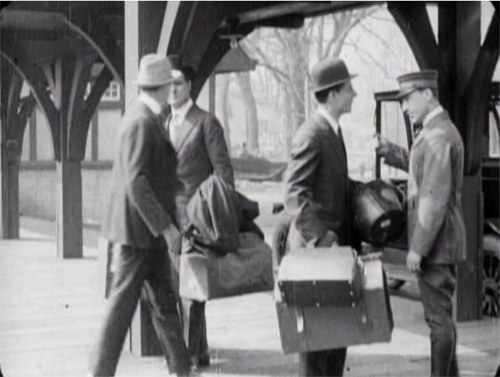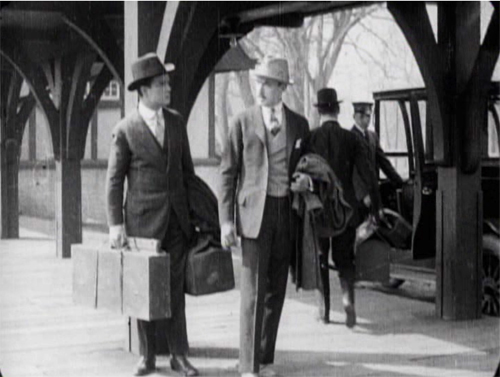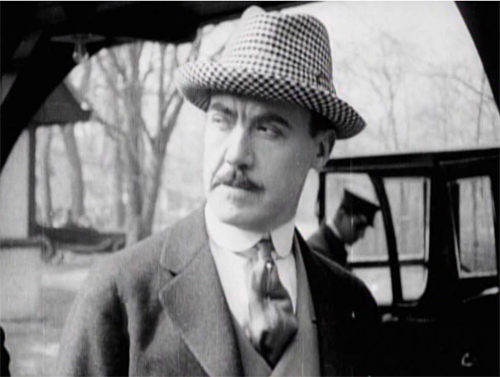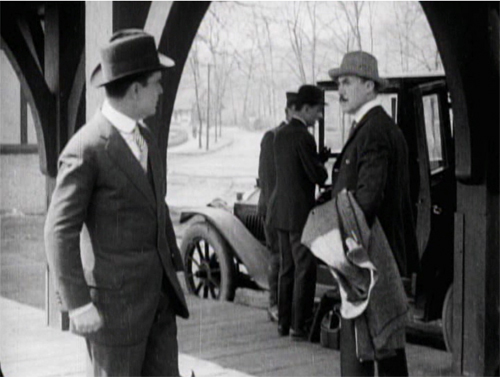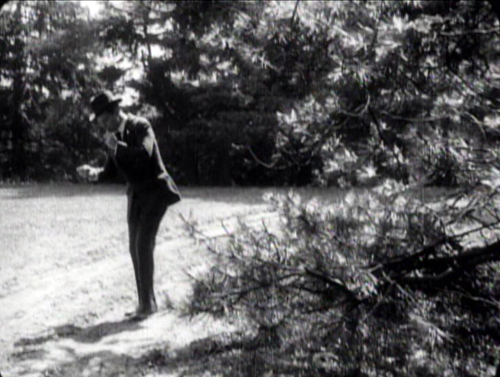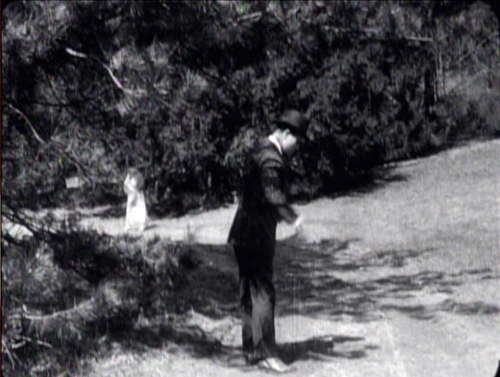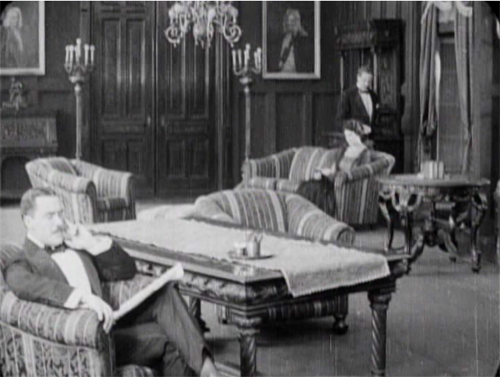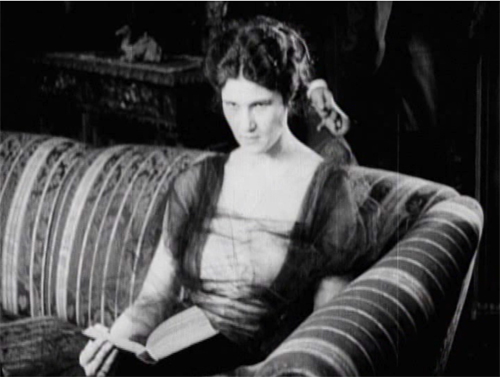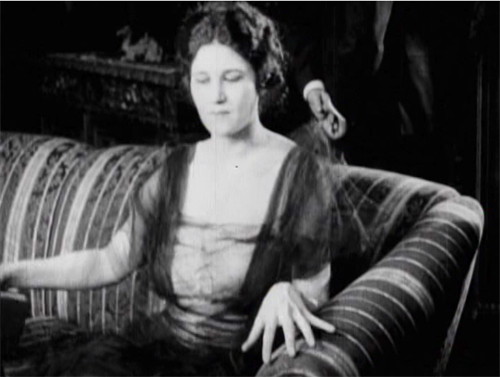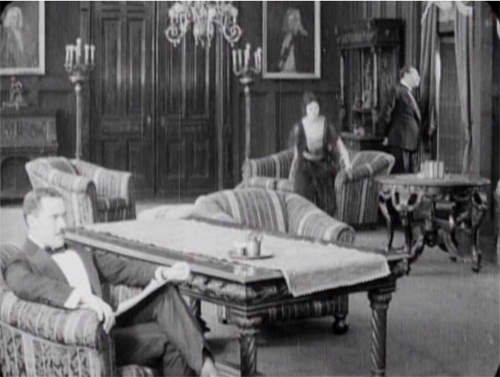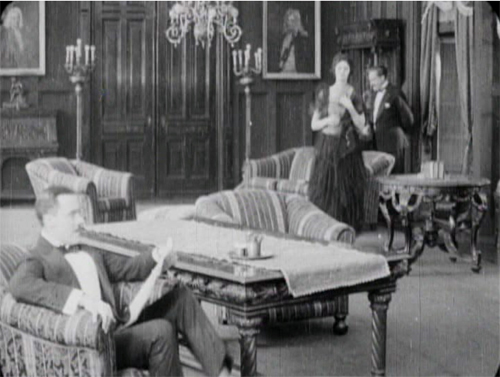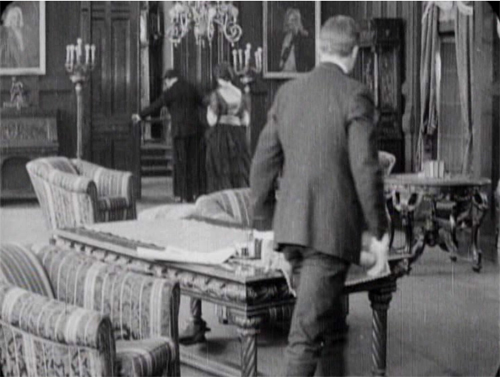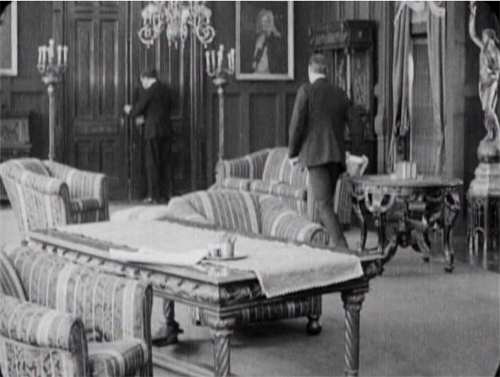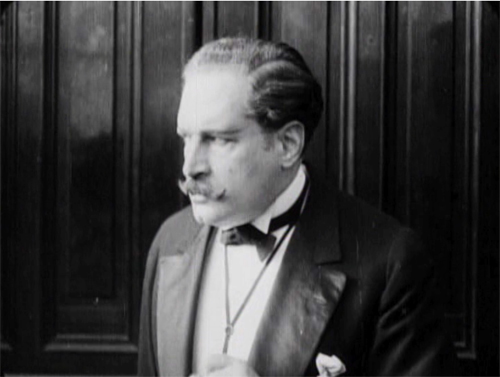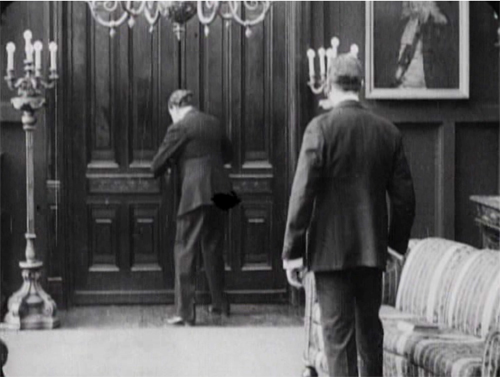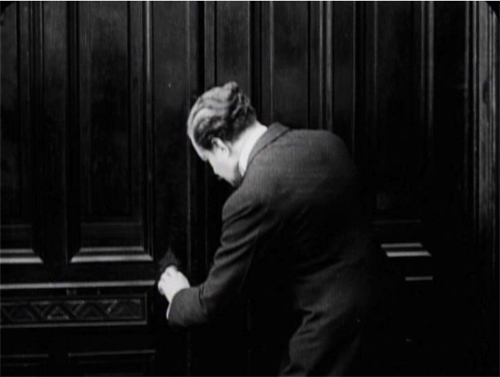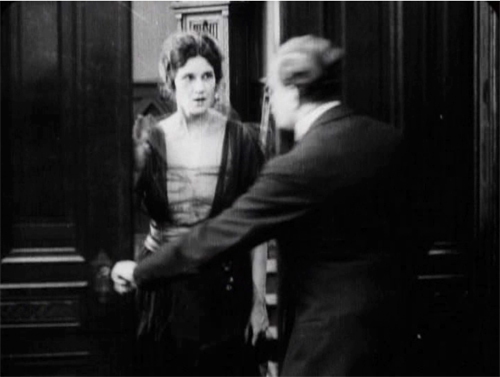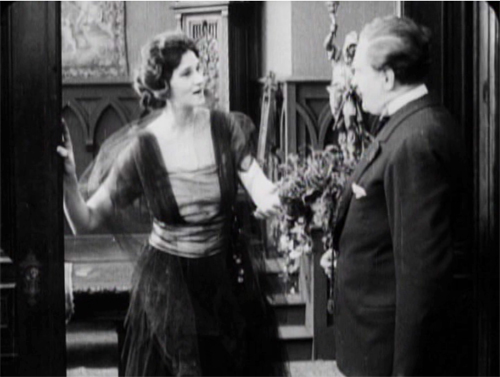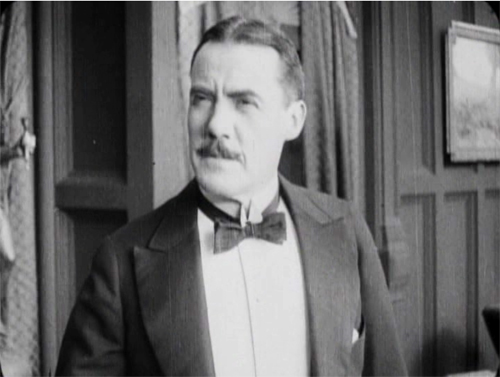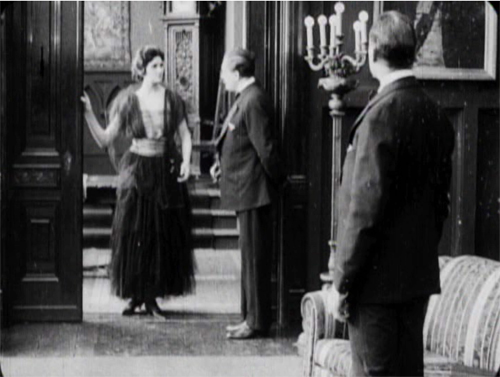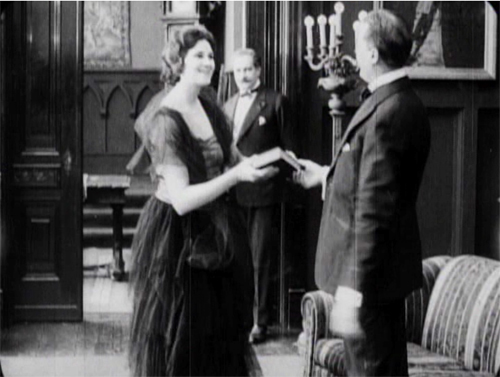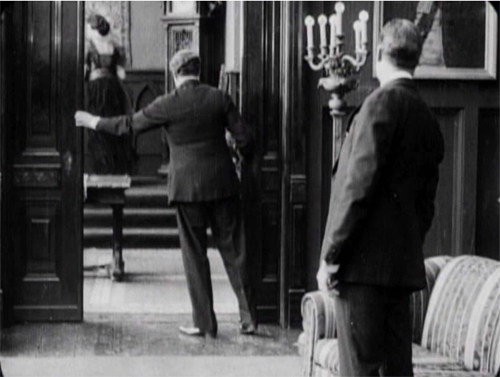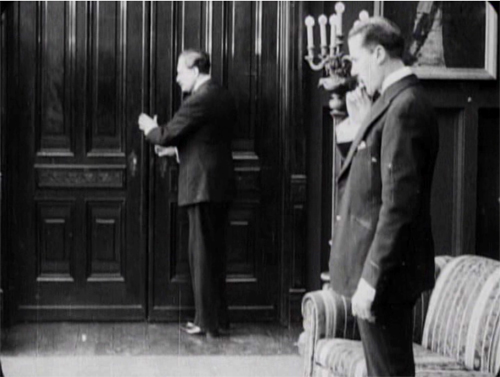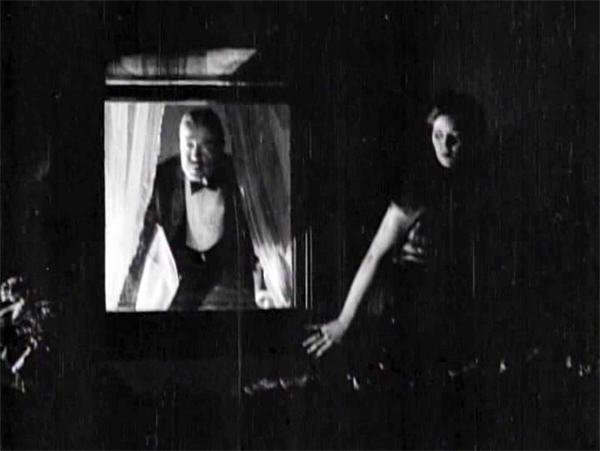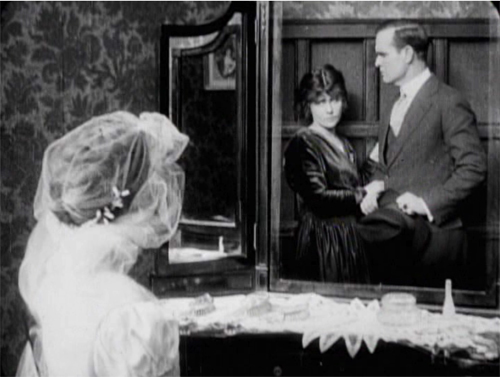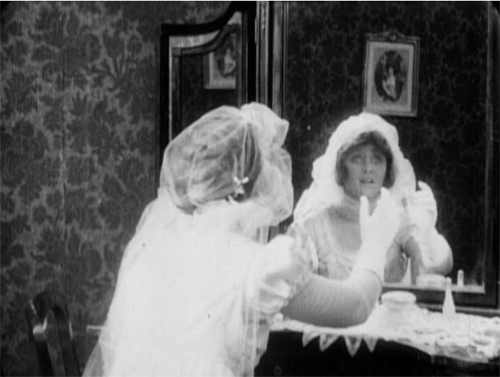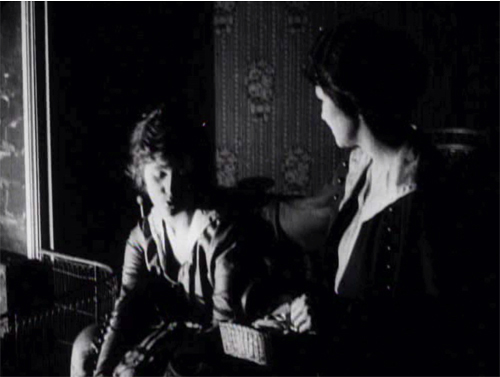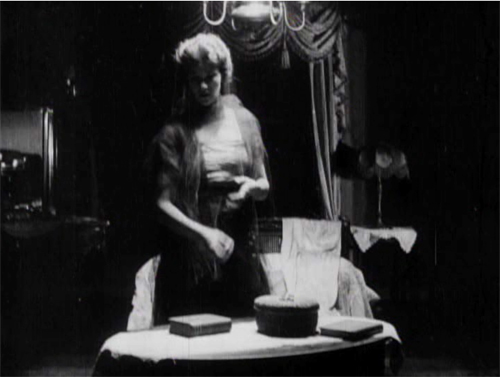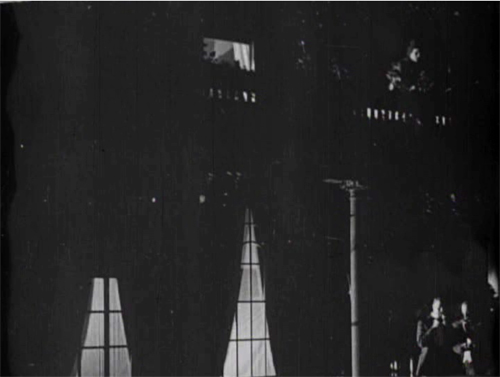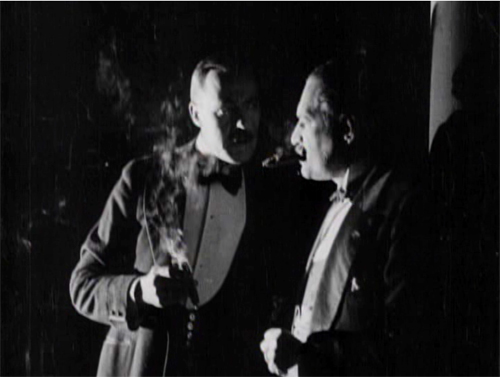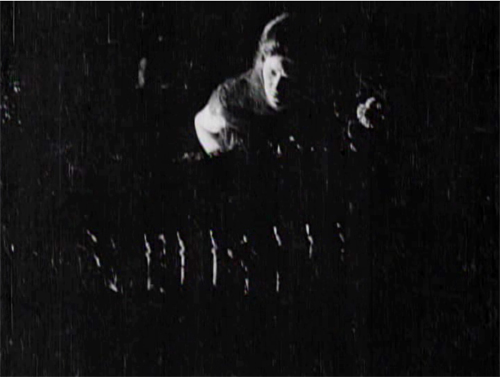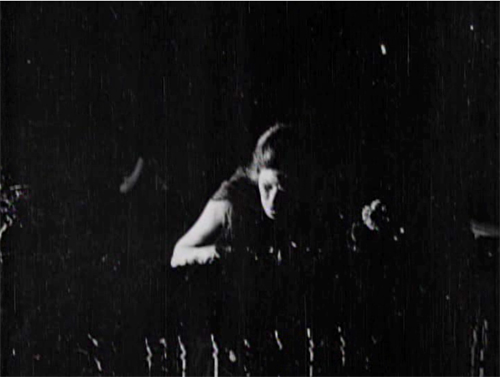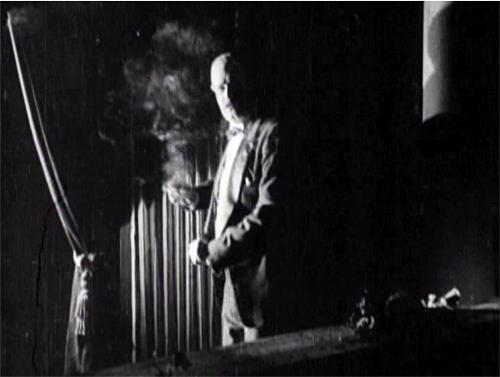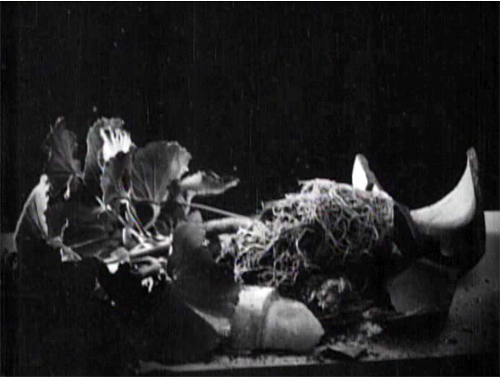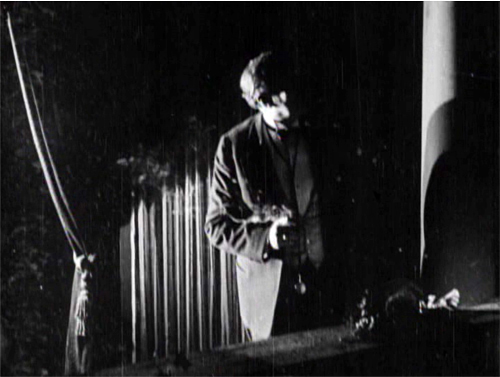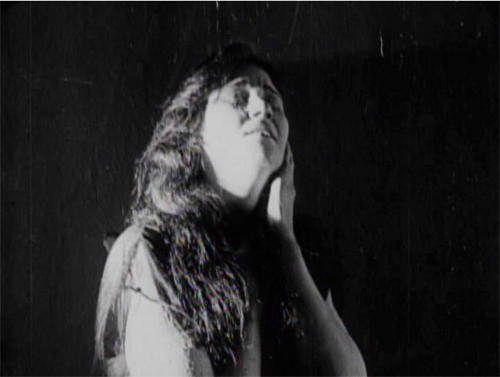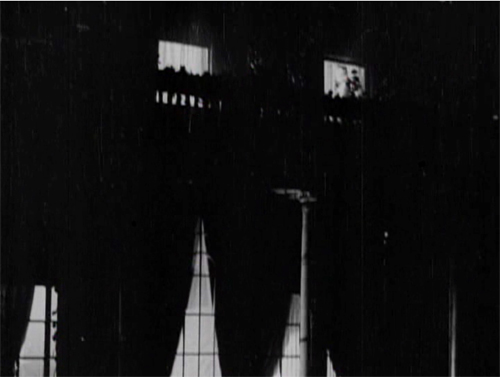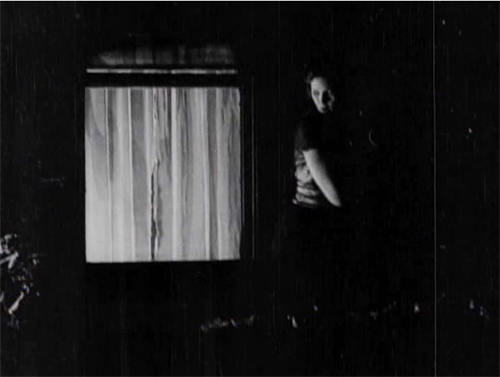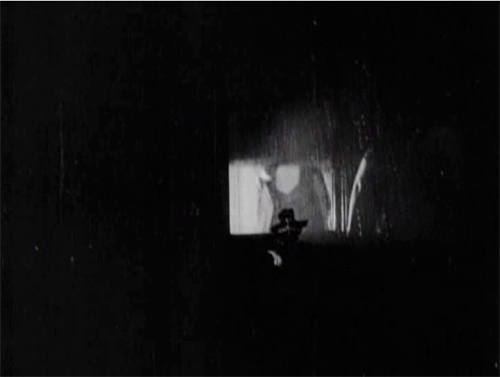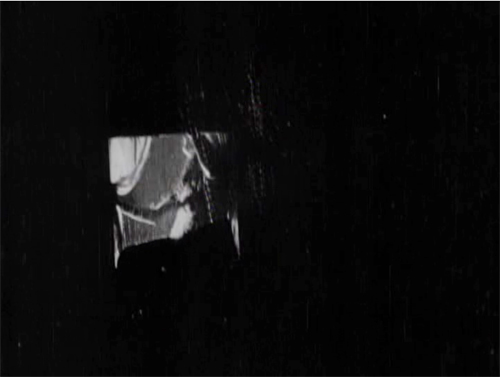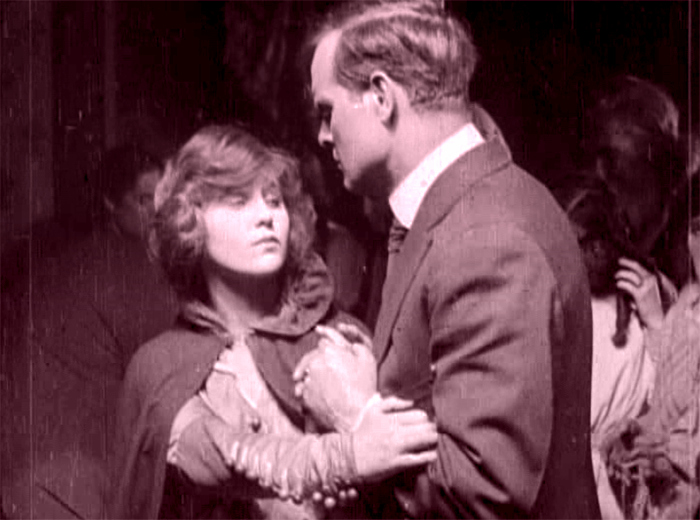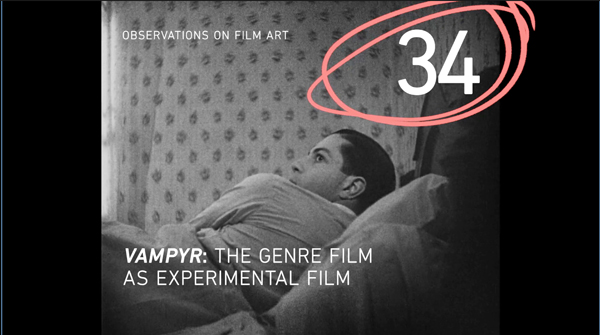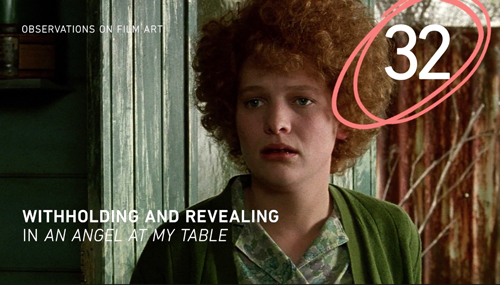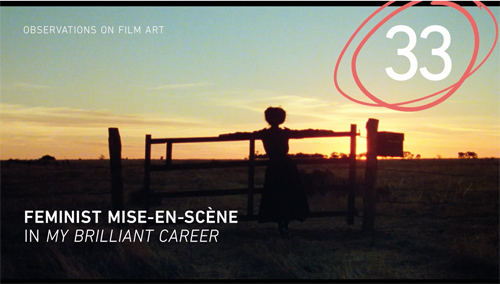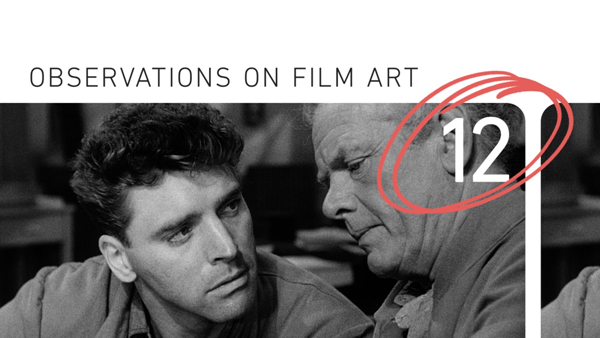Archive for the 'Film technique: Staging' Category
Lau Kar-leung: The dragon still dances
Lau Kar Leung (aka Liu Chia-liang, 1936-2013); Gordon Liu Chia-hui (aka Lau Kar-fei, 1955-).
DB here:
Back in 2020, I was asked to prepare a video lecture on the Hong Kong filmmaker Lau Kar-leung. Under the auspices of the Fresh Wave festival of young Hong Kong cinema, a retrospective and panel discussions were sponsored by Johnnie To Kei-fung and Shu Kei. The event took place in summer 2021. Tony Rayns also participated, offering a deeply informative talk that’s available here, but mine was not included. At a time when I hope people will continue to remember all that Hong Kong popular culture has given us, I’ve recast it as a blog entry.
For some years I’ve been arguing that the martial arts cinema of East Asia constitutes as distinctive a contribution to film artistry as did more widely recognized “schools and movements” of European cinema like Soviet Montage and Italian Neorealism. The action films from Japan, Hong Kong, and Taiwan have revealed new resources of cinematic technique, and the filmmakers have influenced other national cinemas. The power of this tradition is particularly evident in Hong Kong cinema’s wuxia pian (films of martial chivalry), kung-fu films, and urban action thrillers from the 1960s into the 2000s.
Chinese martial arts are well-suited to the movie screen. The performance discipline, seen both in the martial arts and in theatrical traditions borrowing from them, yields a patterned movement that lends itself to choreography. The staccato quality of motion yields a pronounced pause/burst/pause rhythm that can be displayed and enhanced by film technique, as we’ll see.
These aspects of martial arts were captured by filmmakers working for the Shaw Brothers studios between 1965 and 1986. They cultivated a local style that yielded films that looked unlike any others. Thanks to the immense resources of the Shaw Movietown studio, complete with big sets and collections of costumes, the new filmmaking style was given a unique force. With The Temple of the Red Lotus (1965) and Come Drink with Me (1966), what Shaws called its “action era” began, and thanks to international distribution Shaws’ swordplay films gained audiences around the world.
Shaws’ Big 3
Shaw Movietown main office, 1997. Photo by DB.
The new trend benefited from Chinese opera traditions and the martial arts novels of Jin Yong, pen name of Louis Cha Leung-yung. They also owed a debt to Japanese swordplay films, many of which Shaws distributed and urged their directors to study. There was as well the influence of Italian Westerns. Just as important was Shaws’ investment in color and widescreen processes. Updating technology not only allowed the films to compete on the world market; it offered rich opportunities for artistic expression. (See the essay “Another Shaw Production: Anamorphic adventures in Hong Kong.”)
Shaws directors quickly established conventions of the new swordplay film. Conflicts, of course, were expressed through combat, at least three major ones per film. One source of friction was the rivalry between martial arts schools run by masters; there might also be competition among traditions, regions (northern/southern), or nations (China vs. Japan). Typically there would be a hierarchy of villains, with our protagonists fighting them in turn. Plots would be more episodic than is typical in Western films. A looser structure favored including extensive set pieces of training or combat that were the appeal of the genre. And the plot would culminate in a long climactic fight, often to the death. These conventions, consolidated in the wuxia pian, carried over into the kung-fu films of the 1970s.
Two directors played central roles in shaping these conventions, and each had a distinctive approach to them. The vastly prolific Chang Cheh (Zhang Che) dominated the Shaws lot. He favored violent plots turning on revenge and intense male camaraderie, in which the martial arts served as a drama of loyalty or betrayal, friendship or deadly enmity. At the same period King Hu Chin-Chuan created one of the breakthrough “action era” works, Come Drink with Me, which immediately established a very different authorial vision. Hu was interested in historical and political intrigue, women warriors no less than male ones, and the martial arts as a spectacle of cinematic grace. Most of his major works, including A Touch of Zen (1971) were produced after he emigrated to Taiwan, although some were distributed by Shaw Brothers.
Neither Chang Cheh nor King Hu was trained in the martial arts, so they relied on choreographers to supply their action scenes. By contrast, Lau Kar-leung was a martial arts director who came to Shaws in the 1960s and choreographed many films for Chang and others. He took over directing duties in 1976 with The Spiritual Boxer and directed over twenty-five films for Shaws until 1985, when the company ceased producing theatrical features. He went on to direct several one-off projects until 2002.
Lau took the uniqueness of martial arts traditions more seriously than other directors, building entire films around one school or another, or among the contrast of rival traditions. He often opens the film with an abstract prologue showing off characteristic moves and tactics of the style that the film will treat. Unlike Chang, he is less concerned with male loyalty and violent revenge and is more inclined toward redemption and forgiveness. He shares Hu’s refined conception of film technique, but he is less overtly innovative. He refined stylistic conventions that were already in place at Shaws and many of which were basic to world cinema storytelling.
For example, Lau accepted the elevated production values demanded by the Shaw product. His films are filled with elaborate sets, both interiors and exteriors, and rich color values. He also recognized the power of editing, something that King Hu had brought to the fore. In the rest of this entry, I’ll concentrate on four of Lau’s distinctive innovations in the Shaws style.
Filling the wide frame
All widescreen filmmakers faced the problem of filling the spacious frame. (See CinemaScope: The Modern Miracle You See without Glasses” for discussion of American solutions.) The big Shaws sets enabled filmmakers to pack the frame with figures and settings. We therefore find plenty of dense long-shot compositions.
We also find flashy closer views. Chang Cheh was particularly fond of low-angle medium shots, which he considered “warmer” than straight-on or high angles (The Assassin, 1967; choreographed by Lau).
Hong Kong directors relied on “segment shooting” for action scenes. Instead of overall coverage, with repetitions for different camera angles (the US norm), they plotted the fighting moves for specific camera angles and shot them separately. By calibrating the performers’ actions to the camera setup, they created a unique blend of martial arts techniques with film techniques. Rather than simply record martial-arts movements, filmmakers “cinematized” them.
Lau seems to have taken particular pleasure in filling his frames in ingenious, fluid ways. He enjoyed the challenge of staging combat scenes in confined spaces, so that he couldn’t rely on expansive vistas. Partly, this tactic enabled him to show how different moves were required in close quarters. One of his favorite sequences was in Martial Club (1981). He explained:
Gordon Liu is fighting Johnny Wong in an alley that narrows from 7-foot to 2-foot wide. The physical limits of the alley actually make the best showcase for the different boxing schools. How do you fight in a seven-foot-wide alley? You use big arm and leg movements. Going down to five-foot wide, you keep your elbows close to your body because you don’t want to expose yourself. Further down to three-or-four foot wide, you use Iron String Fist. Finally when you get down to two-foot wide, you engage the “sheep trapping pose.” The results were sensational.
At the same time, the narrowing alley offered rich opportunities to fill the frame with body parts and abstract slices of walls.
Something similar occurs in Legendary Weapons of China (1982), where two assassins must hide in an alley above a third. This time Lau uses some props to fill out the wall areas.
Lau delights in the possibilities of close fighting in any space. Sometimes the confinement isn’t a matter of setting; it’s dependent on letting the film frame itself constrain the action. Take a portion of a sequence from Dirty Ho (1979). The Prince (in disguise) calls on Mr. Fan, who tries to attack him, all the while pretending to play the host by offering wine.
Establishing shots lay out the zones of action to come, the chairs the men will occupy. Even a momentarily unbalanced framing is compensated for by movement in the empty area.
The first phase of the scene takes place in much closer framings, often tight two-shots. It’s here we see Lau’s virtuosity in finding constantly fresh ways to fill the frame, with compositions always picked for maximum clarity: that is, in showing Fan’s aggression and the Prince’s resourceful blocking, sometimes with comic symmetry.
The pause/burst/pause rhythm gets played out in low angles, with slight camera movements to adjust to the gestures.
The two major props, the fan and cups, get a real workout as they participate in the constant ballet of arms, faces, and fingers. All areas of the screen get activated: top, bottom, corners and sides.
Later in the scene, in a passage I haven’t included in the clip, the servant gets to take part, so now even more body parts are spread across the frame–and a cup even comes out at the viewer.
The scene ends with a comic commentary on the props: master and servant collapse at the table as a cup overturns.
This “close-up action scene” is as fully designed for the widescreen as any expansive long-shot sequence might be, but there’s a particular enjoyment to be had in seeing how a director can do so much with simple components.
Editing: Analytical cutting
Contrary to what many think, Chinese action pictures rely heavily on editing. At Shaws, King Hu pioneered extremely rapid cutting, reducing shots to half a second or less. Lau became a rapid cutter as well; his films from the 1970s and 1980s typically average three to five seconds per shot, with some films containing over 1000 shots.
It’s commonly said that Hong Kong martial arts films favored full shots and long takes, the better to respect the overall dynamic of the combat. Full shots, yes; but not necessarily long takes. While Western directors tended to believe that long shots had to be held quite a bit longer than closer ones, Hong Kong directors realized that long shots could be cut fast if they were carefully composed for quick uptake. Lau’s mastery of composition stands him in good stead when he starts putting shots together: every combat, even the fast-cut ones, are crystal-clear in their execution.
Directors across the world had settled on two major editing resources: analytical cutting and constructive cutting. The first type shows the overall spatial layout of a scene and then analyzes it into partial views. Our Dirty Ho sequence is an example. Constructive cutting deletes the establishing shot and relies on other cues to help the viewer build up the scene mentally. Hong Kong filmmakers made extensive use of both types, and as you’d expect Lau is a master of each.
Most Hong Kong directors used analytical editing to favor the actors, to pick out their reactions to the ongoing action. Lau does this as well, as is seen in Dirty Ho. As you’d expect, Lau also uses cuts-in close views to emphasize combat tactics. In Challenge of the Masters (1976), after a villain (played by Lau) has felled his opponent, analytical cuts build to a revelation of a metal attachment to his shoe.
Executioners from Shaolin (1977) illustrates how Lau uses analytical editing during a large-scale fight scene. It’s far less constrained than the tabletop action of Dirty Ho, but he does find ways to narrow the action to particular zones. This is done through cuts to closer views–sometimes very close ones. And the editing is swift, with the average shot lasting only four seconds.
The scene’s opening establishes the hero Hung Hsi-kuan arriving at Pai Mei’s temple. There are two establishing shots, one a pan-and-zoom that presents the temple as Hung arrives, while the other (below) is a zoom back keeping the temple and Hung in the same frame. Both compositions stress the steep stairs leading up the hillside.
Once Hung starts up the stairs, more establishing shots reveal him surrounded. Lau indulges in a feast of different angles, stressing Hung’s vulnerability.
The scene’s second phase follows Hung’s progress up the steps. His encounters with many defenders are captured in a variety of angles, all of them orienting us to the changing situation. (At the top, he’ll encounter Lau himself, wielding a jointed staff.)
Camera setups on the steps themselves keep us aware of the forces arrayed around him. And the steps function a bit like the alleys in other films to limit the range of action.
The camera really penetrates the action, picking out details in the sort of tightly packed framings we saw in Dirty Ho.
Lau remarks: “You can get wonderful scenes of two pairs of hands folding and sliding in and out of each other’s grip.” This sort of tangible physical action is central to Lau’s scene analysis.
Analytical editing can include matches on action, cuts that let movement carry over across shots. Lau gives a virtuoso example in a match-on-action between extreme long-shots of a man in blue sent sprawling. The second shot ends with a zoom back.
It’s possible that Lau used two cameras for coverage of this, but that was a rare option in Hong Kong. It’s just as likely he managed the cut by repeating the fall, a movement stressed by a zoom back.
Again, you get a sense of a filmmaker challenging himself by setting up problems he will need to solve through mastery of his craft.
Editing: Constructive cutting
Trampolines and mattresses in shed on Shaw Movietown lot. Photo by DB.
The wuxia tradition features exponents of the “weightless leap,” the ability to spring very high into space. Before the advent of wirework and CGI, these soaring warriors were treated through editing that shows the leap in a series of shots. For instance, constructive cutting in Chang Cheh’s Golden Swallow (1968, choreographed by Lau) shows Silver Roc launching himself, soaring, and descending on his victim.
The jump was probably facilitated by a trampoline. On the screen, though, we see portions of the action that we assemble in our heads.
With his usual ingenuity, Lau sought out situations where he could test his skill with constructive editing–not just weightless leaps but combats among fighters at some distance from each other. My example is a brilliant sequence from Legendary Weapons of China (1982). (It takes place in semidarkness, so you may wish to adjust the brightness of your monitor.) Two rival assassins clash in a loft as they try to kill a third in the bedroom below. There ensues a three-way fight, pursued mostly through careful constructive editing.
There are a few establishing shots situating Ti Hau and Fan Shao Ching (disguised as a man) in the loft, but once they change their locations, most of the combat is given through constructive editing. That technique relies on cues of setting and character behavior (body position, facial expression, eyelines), and these are all mobilized early in the scene.
Details of props help us understand the action as well: the two threads bearing hooks and especially the gag with gas.
Once the assassin Ti Tan arrives on the floor below, pure constructive editing takes over. There’s no framing that includes him and his two attackers.
So Lau proceeds to cut together an ongoing fight upstairs (complete with fake meows) with Ti Tan’s suspicions downstairs.
The scene culminates in Fan and Ti Hau fleeing as Ti Tan, still suspicious, doubts that all the noise above him was created by a cat–and even the cat is presented through constructive editing.
In a sequence of 126 shots, the average is about two seconds, but each one is legible at a glance and carries the scene forward with utter smoothness. Lau’s precision in shot design serves him well when we have to assemble the action in our minds.
The smash zoom
Hong Kong action films of the 1960s are notorious for their use–some would say, over-use–of zoom shots. Yet at the time directors throughout the world were exploring the artistic possibilities of zooms. Most notable was the Hungarian Miklós Jancsó, who coordinated the zoom with complex movements of actors and the camera. So we ought to consider the possibility that the zoom in Hong Kong was more than a technical gimmick to spice up action scenes.
For example, a smash zoom can accentuates the pause/burst/pause pattern of the fight. During one combat in Chang Cheh’s The Blood Brothers (choreographed by Lau), the zoom emphasizes sudden bursts of action by whipping back from a fighter.
Alternatively, the zoom can play up the pause by calling attention to moments of stasis. Here a cut emphasizes the pause as the fighters’s weapons are locked before the fight resumes with a zoom back.
In such ways the zoom can break the fight into discrete stages. A far more elaborate instance takes place in Lau’s Return to the 36th Chamber (1980). Chu Jen-chi has painstakingly learned kung-fu at the temple through an apprenticeship of lashing bamboo poles together to make scaffolding. Accordingly, his technique is based on this very particular set of skills. I concentrate on the early stretches and the clip gives you some extra niceties. The whole thing is exhilarating to behold, thanks partly to energetic zooms.
Early on, the zoom introduces us to the lashing technique by showing the robe’s ripped fabric as a kind of handcuff.
Again we see Lau’s interest in watching how hands work, but here it becomes a specific combat tactic. The ensuing action will revolve around hands and wrists, and Lau’s zooms set up a question: What is Chu’s overall strategy?
The answer comes in a series of variations. First, Chu lashes his adversary to a bamboo pole like captured wild game.
Variation 2: Ensemble work. Chu takes on a batch of men, trussing them up horizontally.
He turns out to have in mind an engineering project, a sort of hitching post of miscreants. It’s capped by a shot of one of the Manchu bullies seeing his disciples’ wiggling fingers.
Variation 3: More ensemble work, now vertical, with the men’s wrists stacked like a bouquet.
Again, a master shot reveals the result and another close-up shows their wiggling fingers.
The kung-fu is of course extraordinary, but it takes an unusual cinematic imagination to heighten such elaborate patterns of movement in ways that are perfectly clear. Chu’s display of serious efficiency has a humorous side, capped by the gags that show the villains utterly flummoxed. We should ask if today’s action sequences in American films have this sort of unforced rigor and exuberance.
In the mid-1980s Shaw Brothers eased out of theatrical filmmaking, devoting Movietown to television production. Lau went on to one-off projects, some of which (e.g., Tiger on Beat, 1988) are well worth your attention. (Go here for the astonishing climax.) He had a late-career resurgence as choreographer for Tsui Hark’s Seven Swords (2005). But his prime achievements, I think, will remain his vastly entertaining and filmically rich Shaws classics. His dedication to the specifics of martial arts lore, his unique sense of comedy, and not least his precise direction brought unique qualities to the remarkable tradition of Asian action cinema.
Chang’s remark about “warm” low angles is in Chang Cheh, A Memoir (Hong Kong Film Archive, 2004), 82; he discusses shooting The Assassin on p. 86. Lau’s comments on Martial Club come from “We Always Had Kung-Fu: Interview with Lau Kar-leung,” in Li Cheuk-to, A Tribute to Action Choreographers (Hong Kong International Film Festival, 2006), 62; the remarks on hands are on p. 59.
I discuss Lau further in both Planet Hong Kong 2.0 and in this blog entry.
Lau as the drunken master in Heroes of the East (1978).
Little stabs at happiness 5: How to have fun with simple equipment
Tiger on Beat (1988).
DB here:
Simple equipment includes, but is not limited to, knives, pistols, shotguns, ropes tied to shotguns, surfboards, chainsaws, etc.
Herewith another attempt to brighten your days with a choice film sequence that never fails to bring a foolish grin to my face. Apologies as ever to Ken Jacobs for my swiping his title.
Tiger on Beat (aka, but less pungently, Tiger on the Beat, 1988) is prime Hong Kong showboating. This final scene assembles some of the greats—Chow Yun-Fat, Gordon Liu Chia-Hui, Chu Siu-Tung (too little to do)–and near-greats like Conan Lee Yuen-Ba, who gets points for heedlessly executing the stunts Chow and Chow’s doubles can’t. Lau Kar-Leung (aka Liu Chia-Liang), one of Hong Kong’s finest directors, imbues both the staging and the editing with the crisp, staccato rhythm that this tradition made its own, and that few American directors have ever figured out. (It’s a long clip, so it may take a little time to load. In addition, our Kaltura operation is having problems, so you may want to try different browsers.)
Come to think of it, this little-stabs entry contains some fairly big stabs of its own.
The whole film is worth a look. Opening scenes feature Chow in outrageous threads, the very opposite of a cop in plainclothes, and there’s a fine car chase in which many risk life and limb. But this sequence, lit high-key so that every splash of saturated color pops, is for me the highlight, a tour de force of action cinema. Probably not for the kids, but what do I know about kids?
Sequences like this were what drove me to teach Hong Kong film and write Planet Hong Kong. They also impelled Stefan Hammond and Mike Wilkins to write Sex and Zen and a Bullet in the Head (1996), the most deeply knowledgeable fanguide to this glorious cinema. Stefan followed it up with Hollywood East: Hong Kong Movies and the People Who Made Them (2000). Now Stefan and Mike have effected a merger of these and updated and expanded them. They’ve also recruited a band of other Guardians of the Shaolin Temple: Wade Major, Michael Bliss, Jeremy Hansen, Jude Poyer, David Chute, Dave Kehr, Andy Klein, Adam Knee, Jim Morton, and Karen Tarapata.
The result is another indispensable volume, More Sex, Better Zen, Faster Bullets: The Encyclopedia of Hong Kong Film. The recommendations are sound, the plot synopses are nearly as much fun as the movies, and the authors have wisely retained chapter titles like “So. You think your kung fu’s. . . pretty good. But still. You’re going to die today. Ah ha ha ha. Ah ha ha ha ha ha.”
They weigh in on today’s sequence: “This gory Armageddon-duet consistently scores on Top Ten End-Battle Lists among HK film aficionados.” Makes me even more confident to recommend it to you. They add that the credits music is “a hard-rocking theme song by HK power diva Maria Cordero.” So I let it run.
I analyze this and other action sequences in this blog entry. An appreciation of Lau Kar-Leung is here.
For more little stabs, check out earlier entries in this series.
Chow Yun-Fat gets his daily dose of egg yolks (Tiger on Beat).
Hollywood starts here, or hereabouts
The Woman in White (1917). Toning by DB.
DB here:
Do you know Wilkie Collins’ The Woman in White? I hope so.
The traps set by this novel of mystery and suspense–a prototype of what was called “sensation fiction”–are still ensnaring audiences. Serialized in 1859-1860, it became one of the best-selling books of the nineteenth century. Merchandisers pounced on it, offering Woman in White cloaks, bonnets, perfumes, and songs. Stage and film adaptations followed. The Brits, always eager to mine classics, have created no fewer than three TV versions (1982, 1997, and 2018). There’s a pretty good Warners “nervous A” picture from 1948, with Sydney Greenstreet as the deadly, jovial Count Fosco.
The 1917 version from the Thanhouser studio is, lucky us, currently streaming on Vimeo for free. It’s also available on DVD, as part of the excellent series of Thanhouser films. The print is a 1920 re-release, but nothing significant seems missing or altered.
Apart from its entertainment value, the Thanhouser Woman in White can teach us a lot about film history. Why? Because it sums up very forcefully what American narrative cinema could do in that crucial year 1917. Forget your Griffith, leave aside (regretfully, just a moment) your Webers and Harts and Fords and Fairbankses. The mostly unheralded team of screenwriter Lloyd Lonergan and director Ernest C. Warde have given us a concise demonstration of the power harbored by classical Hollywood from the start. The storytelling tools assembled in that era remain with us still.
Women in peril
The novel’s plot is a tale of–well, plots. Counterplots too.
Collins’ book is hugely complicated, swirling together secrets, hidden identities, abduction, impersonations, illegitimate birth, bigamy, insanity, forged records, fake tombstones, assorted hugger-mugger, and timetables that even the author had trouble keeping straight. The intricacy is magnified by Collins’ decision to adopt a “casebook” structure, in which participants and onlookers write up their accounts of what they witnessed. Each piece of testimony is restricted wholly to one character’s viewpoint, and the writers are forbidden to fill in material they learned later. “As the Judge might once have heard it, so the Reader shall hear it now.” This stricture isn’t fully observed, though, because at least one witness sneaks looks at what counterparts have written.
The book’s key image is, of course, the apparition that greets Walter Hartright on the road one sultry night.
There, in the middle of the broad, bright high-road–there, as if it had that moment sprung out of the earth or dropped from the heaven–stood the figure of a solitary Woman, dressed from head to foot in white garments; her face bent in grave inquiry on mine, her hand pointing to the dark cloud over London as I faced her.
Recovering his senses (“It was like a dream”), Hartright listens to her gap-filled story and helps her find a cab. But soon he sees two bravos halt their carriage and hail a policeman. They ask: Has he seen a woman in white? No. Why does it matter? What has she done?
“Done! She has escaped from my Asylum. Don’t forget: a woman in white. Drive on.”
The first installment ends here, and the adolescent window opens a little wider.
The main plot centers on Laura Fairlie and her half-sister Marian. Hartright is engaged as Laura’s drawing teacher and they fall in love. But Laura’s father has promised her to Sir Perceval Glyde, an apparently upright aristo. (Collins was opposed to marriage as an institution. His class hatred comes out as well, though perhaps not as scathingly as it does in his other masterpiece, The Moonstone.) Once the marriage takes place, Glyde introduces into the household Count Fosco, a suave “doctor” with the habit of letting his pet mice scamper around his waistcoat. It doesn’t take long for Marian to realize that Glyde has a Secret, and she must turn detective to protect Laura from him.
Without pressing into spoilers, you can already tell that this lays down a template for the sort of story Hollywood would later love to tell. The Woman in White is a prototype for the woman-in-peril plot that we’ll find in Suspicion (1941), Shadow of a Doubt (1943), The Spiral Staircase (1946), The Two Mrs. Carrolls (1947), Sleep My Love (1948), and many 1940s classics. These in turn rely on literary works in Collins’ wake by Mary Roberts Rinehart, Mignon Eberhart, and other women authors who updated Gothic and sensation-fiction conventions for the twentieth century.
Lloyd Lonergan was said to have suggested reducing the eight-reel cut of The Woman in White to only six. It’s indeed a tightly coiled presentation of Collins’ sprawling plot. Swathes of backstory are dropped. Instead of Collins’ multiple narrators we get an omniscient narration that shifts freely across various intrigues. Fairly quickly we learn that Glyde and Dr. Cumeo (the Fosco of the novel) are scheming to switch Laura with her lookalike Anne, the woman in white. We also realize that Marian, as an obstacle to the plan, is in mortal danger. Thanks to crosscutting, we’re aware of several lines of action unfolding at once, and in a film full of spying and eavesdropping, compositions tell us who’s snooping on whom.
Still, some revelations are saved for the end, notably one that looks forward to the flashback-heavy 1940s. When Laura and Marian discover Glyde’s secret, their informant gives them the crucial information in a flashback, which precipitates a fiery climax. The flashback device was previewed when Marian, recovering from her collapse, recalled the plans she heard on the patio between Glyde and Cumeo; a nearly Surrealist dissolve superimposes that earlier scene.
In preferring to give us a lot of information, favoring suspense over surprise, this Woman in White is typical of Hollywood scriptwriting of the classical years. In particular, the film employs strategies later elaborated by Hitchcock (discussed here and here and here). One scene in particular displays the Hitchcock touch, years before Sir Alfred took up filmmaking. Even more specifically, let’s note that the basic situation looks forward to Notorious: a woman imprisoned by her husband and a confederate is slowly softened up for disposal.
Choreography, cutting, and showing us the door
Anyone who has viewed films with critical attention must be aware that in a film we are constantly, and without knowing it, being directed what to look at. In a stage play you may be looking at one moment at the actor who is speaking; at another moment watching the face of the person addressed, or observing the behaviour of other characters on the stage. If you go repeatedly to the same play, you may choose to look at different actors in a different order, for you certainly cannot observe everybody and everything simultaneously. But in a film, the lens of the camera is constantly telling you wha to look at–it may be a close-up of the actor’s hand, by the movement of which he betrays the emotion not visible in his face.
T. S. Eliot, 1951
The 1910s were an exciting era in cinema because, as I try to show in this video lecture, the foundations of “our cinema” were laid then. The film business, movie culture, and mass audiences settled into patterns that would hold for over a hundred years.
Just as important, the forms and styles of film craft were put in place. Among those changes was a transition from a style that relied on performance and staging to an approach more reliant on editing, on breaking scenes into many shots. The dominance of editing as a principle of guiding attention is evident from the Eliot quotation; he can’t conceive that staging, lighting, and other “theatrical” techniques could steer us to the important parts of the action.
The earlier, “tableau” approach to scenes was perfectly capable of funneling attention too, but editing had many advantages, both economic and aesthetic. By 1917, as Kristin and Janet Staiger and I argued in The Classical Hollywood Cinema, the editing-based approach had coalesced into the dominant style. The Woman in White is a nifty illustration of what an ordinary film from that year could accomplish with cutting–while still retaining vestiges of the tableau style.
A simple example of the tableau technique comes when Sir Perceval Glyde calls on Laura and Marian. He has just kissed Laura’s unwilling hand, and Marian comes up from the rear of the shot to him. As she moves forward, Laura shifts aside slightly to clear our view of the others. This choreography doesn’t seem stilted because it expresses Laura’s withdrawal from her fiancé.
This is an example of the Cross, the staging technique that coordinates actors’ switching positions in the frame. Marian moves from frame left to frame right as Laura shifts to the left.
The tableau approach often plays between a lateral arrangement of characters in the foreground and a more diagonal array of figures packed into depth. As the shot unfolds, Marian is given a beat to take notice of Laura’s reaction as Glyde retreats to the background. She conveniently blocks his departure as she looks warily back at him.
But Glyde steps back into visibility in the distance as he says goodbye, with the women turning away from us so that we’re sure to concentrate on him. Then as the women turn back to react, he can be glimpsed leaving on the far right.
Doorways in the distance, characters advancing to and retreating from the camera, figures spreading themselves out horizontally but also blocking our view of things behind them, only to reveal them at the right moment–these tactics of the tableau became supple and subtle during the late 1900s and throughout the 1910s.
Eliot need not have worried that our attention would stray. Centering, frontality, movement vs. stasis, lighting, gesture, and other creative choices push us to notice the important elements of the scene. And these factors aren’t equivalent to what we see on the theatre stage; the optical properties of the camera lens create a very different playing space. (See here and here.)
Tableau staging hung on in editing-driven cinema, but it tended to be relegated to the role of an establishing shot. The first part of this scene consists of another tableau setup broken by a cut when the slimy Glyde kisses Laura’s hand.
Here the closer view underscores his gesture while isolating Laura’s concern.
The coordination of staging and cutting is nicely shown when Walter Hartright, having resigned from his post as Laura’s teacher, accidentallly encounters Glyde at the train station. Glyde is coming to arrange his marriage to Laura, so the plot needs to establish the friction between the two men early on. As they confront each other, Glyde’s assistant loads his luggage into the cab in the background.
The first phase of the scene choreographs the men’s encounter through the Cross.
Then close views underscore the significance of the encounter.
Cut back to a two-shot that reorients us.
The fact that it’s not the same framing as we saw at the start indicates the reliance of the style on editing; even the full view is re-calibrated in light of changing shot scales. And during the shot of Walter, Glyde’s position has changed from his orientation in his medium shot. That’s the sort of flexibility editing gives you. The new arrangement heightens the clash of the two men. (Typical of the 1910s emphasis on depth, Glyde’s assistant and the driver continue to load the cab in the background.)
Glyde’s enlarged hand kiss and the inserts of the two men in the station scene exemplify the axial cut. This is a cut made along the lens axis of the camera–a straightforward enlargement of a chunk of space. It’s very common in 1910s cinema, and it’s still around, though it’s not as common as it was. Editors came to prefer analytical cuts that were more angular, yielding less the sense of a sudden enlargement. Sometimes you’ll see claims that cut-ins or cut-backs should shift the angle by 30 degrees. Yet Kurosawa and Eisenstein made powerful use of the axial cut, and it’s sometimes used as a self-conscious device. During the 1910s, some directors began using the over-the-shoulder (OTS) framing as a way to assure distinct angle changes.
The cut to Glyde’s creepy kiss is also a match on action, smoothly linking Glyde’s gesture across the shot change. This too emerged in the 1910s and became a mainstay of classic editing technique, to this day. (See my earlier post on Watchmen for contemporary examples.)
The Woman in White has several adroit matches on action, which shows that the learning curve among directors was more or less complete by 1917. When Walter first encounters the mysterious woman on the road, his striking a match is carried across a cut, with the second shot introducing her coming toward in him n the distance.
One of the most common editing devices of classical continuity is the eyeline match, and filmmakers were mastering this from quite early on. By 1917, it was part of every director’s tool kit. We can see how it works together with the other techniques in a fine, smooth scene that leads up to a crucial turning point in the action. Glyde and Dr. Cuneo are in the library, where Marian is uneasily reading a novel. Cuneo moseys over behind her, softly threatening, and an axial cut matching his movement lets us know she notices.
Another match on action brings her off the sofa. Love those delicately splayed fingers.
As she starts to leave, we get the Cross, as Glyde rises from his armchair and goes frame right. We now get the start of a major piece of business: Cuneo’s byplay with the sliding doors.
Securing their privacy, Cuneo prepares to consult with Glyde about their skulduggery. But a match on action, carried by a powerful axial cut–a huge enlargement from the extreme long shot setup–alerts us. He’s listening.
Another match on action as he busies himself with the door. A new diagonal composition prepares us for a shot of Glyde to come shortly. And yet again Cuneo is matched as he opens the door.
The payoff: Cuneo has detected Marian outside listening. She bluffs, saying she left her novel behind.
Now comes the shot that was prepared for by the over-the-shoulder long shot above. It’s not an axial cut, but a genuine reverse angle on Glyde, who’s suspicious about Marian’s return.
This is a killer shot because the camera can assume a drastically new position. It has put us in between the characters in a way we weren’t in the station scene. In effect, there’s an axis of action running from Glyde to the doctor and Marian at the door. The reverse angle is a one-off technique at this moment, but the possibility of penetrating the dramatic space in this way will be central to continuity cutting.
Now tableau principles can kick in. Marian comes forward and gets the book while Cuneo watches warily in the background.
In the course of the shot, Marian leaves, and this time, thanks to deep staging, we and the plotters can see she’s not eavesdropping. As she goes upstairs, Cuneo closes the door and the men can settle down to scheming.
Five matches on action, a striking eyeline match, restrained but pointed performances, and a cogent staging of the action have yielded a vigorous, engaging scene. By 1917, classical screen storytelling is well established in even a run-of-the-mill production. But there’s nothing run-of-the-mill about the suspense that follows this trim tension-builder.
1910s noir rides again
The Woman in White illustrates a lot of other 1910s innovations in pictorial storytelling. There are, for instance, some concise special effects, as when on Laura’s wedding day she sees herself and Walter in her vanity mirror.
There are also dramatic lighting effects, motivated by firelight, single lamps, and eventually lightning flashes.
But more audacious is a sustained experiment in “1910s noir.” At that period filmmakers began associating crime and mystery with shadows and stark lighting. (See this entry.) When Glyde and Dr. Cuneo adjourn to the terrace to discuss their scheme, we get a remarkable instance. I won’t indulge my impulse to shower you with images, but I’ll try to suggest why you should try to see the sequence for yourself.
While the men smoke and talk outside, Marian has seen to the sleeping Laura before going to her own bedroom. (A sign of the film’s tidiness is the way it establishes the main characters’ rooms in the upstairs hallway. This geography becomes important when Glyde and Cuneo exchange Anne for Laura.) Opening her window, Marian hears the men outside and ventures onto the balcony above them. This yields a remarkable extreme long shot: She eavesdrops from above.
It’s a difficult shot by later standards. The main action is wildly decentered, set off on the right. But at least this framing has the virtue of preparing us for the later development of the scene, which will involve Marian sneaking along the balcony back to her room, where the light comes from.
The vertical layout of the action is immediately clarified by two closer shots, a lovely chiaroscuro image of the men and the other of Marian listening.
She hears just enough to suggest the men’s scheme before complications ensue. Glyde goes inside and upstairs, where he might discover her. Meanwhile, a rainstorm starts, and Marian dislodges a potted plant. Cuneo turns, in a new setup that emphasizes the railing in the right foreground, so that we can see the fallen plant. The shattered pot is given a close-up more or less from Cuneo’s viewpoint. His reaction supplies a moment of suspicion.
Marian, now drenched by rain, seems trapped between her two adversaries. Will one or both discover her?
Glyde who has gone to Laura’s window and is looking around outside. We’re reoriented through a new master shot of the house, a framing that varies from the original setup. The shot shows both Laura’s and Marian’s windows lit. There follows a dark passage in which Marian creeps up to Laura’s window. That action takes place in the shot I’ve put up above.
An extra twist: Glyde looks out, but then pulls the shade. Little things mean a lot. A soaked Marian manages to crawl back through her window.
Apart from its virtuosity in handling cutting and lighting, the sequence is crucial for the plot. Marian collapses from her exposure to the storm, and her illness provides a pretext for Cuneo to isolate her while he and Glyde proceed with their plan.
I invoke Hitchcock because this long passage of suspense depends on our knowing all the relevant factors in the situation, and the possibility of a giveaway–the smashed plant–drives up the tension. What I’m really saying, I guess, is that Hitchcock expanded and deepened story mechanics that were already in place in the silent era. Apart from refining them, he managed to brand them as his own.
No film from 1917 or thereabouts is faultless in executing the new editing-based style. The Woman in White has its share of mismatches. Then again, so do movies from the 1920s to the present. (Don’t get me started on the mismatched cuts in The Irishman, 2019.) The crucial point is that the system of Hollywood storytelling and style is in place, and not in a crude form. Talk all you want about post-classical cinema, chaos cinema, post-cinema–whatever. The variations we detect today arise against a background of stable norms that remain a lingua franca of world filmmaking, and they’re headed well into their next century.
Thanks to Ned Thanhouser for years of faithful service to the studio’s legacy. Now is an ideal time to visit his site for background on this remarkable company and the efforts to preserve its output. A staggering 132 Thanouser films are available for streaming on Ned’s Vimeo channel.
To find out more about what preceded this crystallization of techniques, see Charlie Keil’s Early American Cinema in Transition: Story, Style, and Filmmaking 1907-1913 (University of Wisconsin Press, 2002).
An excellent survey of Collins’ place in the history of dossier novels is A. B. Emrys, Wilkie Collins, Vera Caspary and the Evolution of the Casebook Novel (McFarland, 2011). Her treatment of Caspary and Laura, both favorites of this blog, is just as valuable. My quotation from T. S. Eliot comes from “Poetry and Film: Mr. T. S. Eliot’s Views,” in The Complete Prose of T. S. Eliot: The Critical Edition, vol. 4: A European Society, 1947-1953, ed. Iman Javadi and Ronald Schuchard (Johns Hopkins University Press, 2018), 581.
For lots more on 1910s storytelling, see the categories 1910s Cinema and Tableau Staging. Flashbacks, the woman-in-peril plot, and other conventions that coalesce in the 1940s are discussed in my Reinventing Hollywood: How 1940s Filmmakers Changed Movie Storytelling.
The Woman in White (1917). Toning by DB.
VAMPYR and more on the Criterion Channel
DB here:
Busy times! I’ve gone back to teaching this semester, and we’re revising Film History: An Introduction. So we’ve been kept from posting as often as we’d like. For the moment just let me signal the newest additions to our Observations series on the Criterion Channel.
In recent installments, Kristin offers an analysis of how film technique suppresses and reveals story points in Jane Campion’s An Angel at My Table. A free extract is here.
Jeff Smith traces how mise-en-scene techniques, especially settings, yield feminist implications in Gillian Armstrong’s My Brilliant Career. Sample it here.
This month, as you see above, I’ve offered a consideration of Vampyr as an experimental film. Again, you can see a clip.
Thanks to the people who’ve told us they enjoy our offerings, now running for nearly three years, longer than Joanie Loves Chachi. Thanks as well as to the group that makes it possible: Peter Becker, Kim Hendrickson, Grant Delin, Erik Gunneson, and the rest of the team in Madison and Manhattan.
With the Channel sponsoring an ambitious seventeen-film Burt Lancaster series, you might check out this entry on Brute Force.












